Managing Human Capital and Leadership - Amazon
VerifiedAdded on 2023/06/04
|17
|5797
|328
AI Summary
This report analyses relevant HRM models for managing human resources at Amazon, discusses organizational HR functions, and analyses the characteristics of an effective leader. The report includes a discussion of the Fombrun, Tichy and Devanna Model, the Harvard Model, the Guest Model, and the Warwick Model. It also discusses Amazon's use of the Balance Scorecard and 360 degree performance evaluation system. The report concludes with a discussion of Maslow's hierarchy of needs and its relevance to employee motivation at Amazon.
Contribute Materials
Your contribution can guide someone’s learning journey. Share your
documents today.
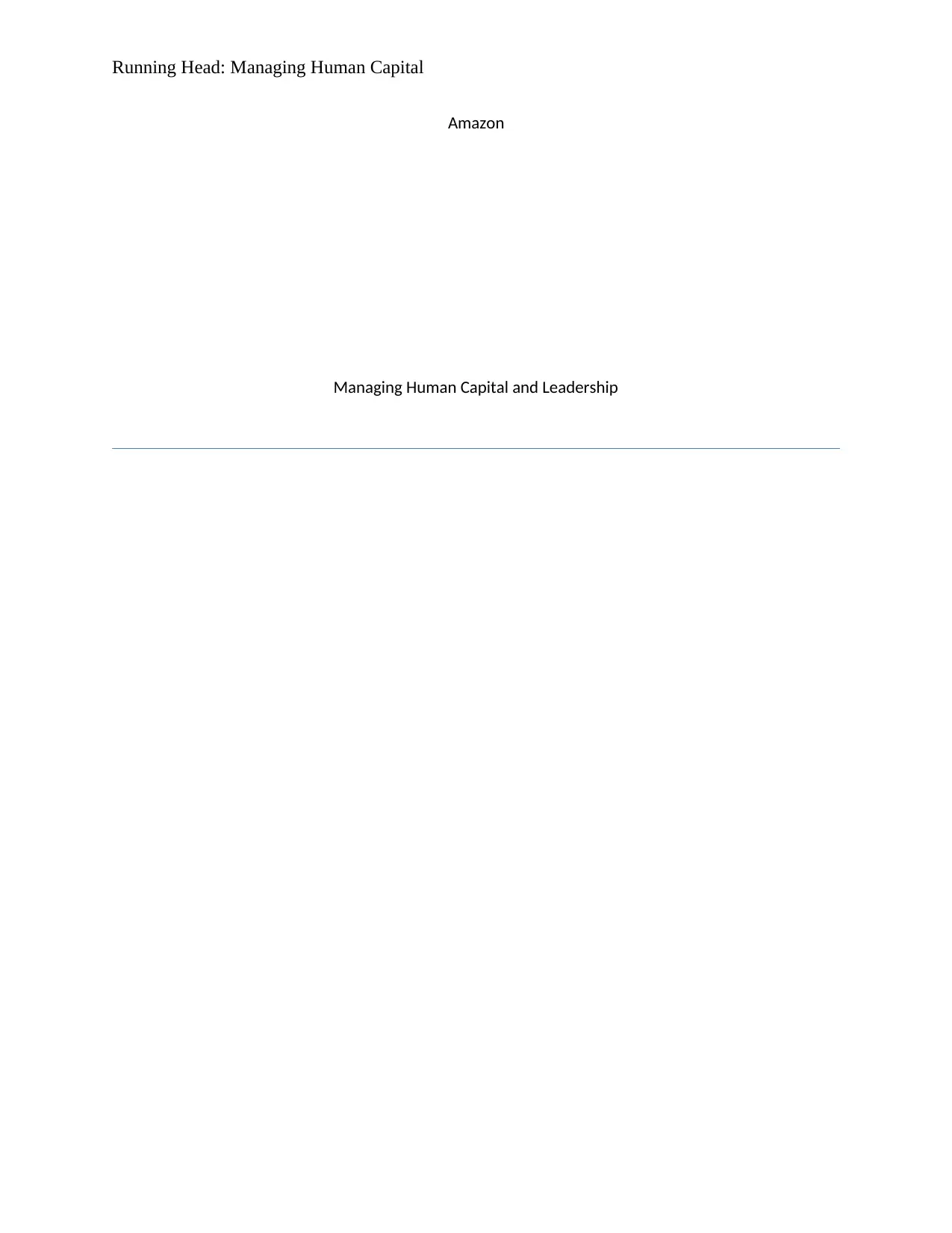
Running Head: Managing Human Capital
Amazon
Managing Human Capital and Leadership
Amazon
Managing Human Capital and Leadership
Secure Best Marks with AI Grader
Need help grading? Try our AI Grader for instant feedback on your assignments.
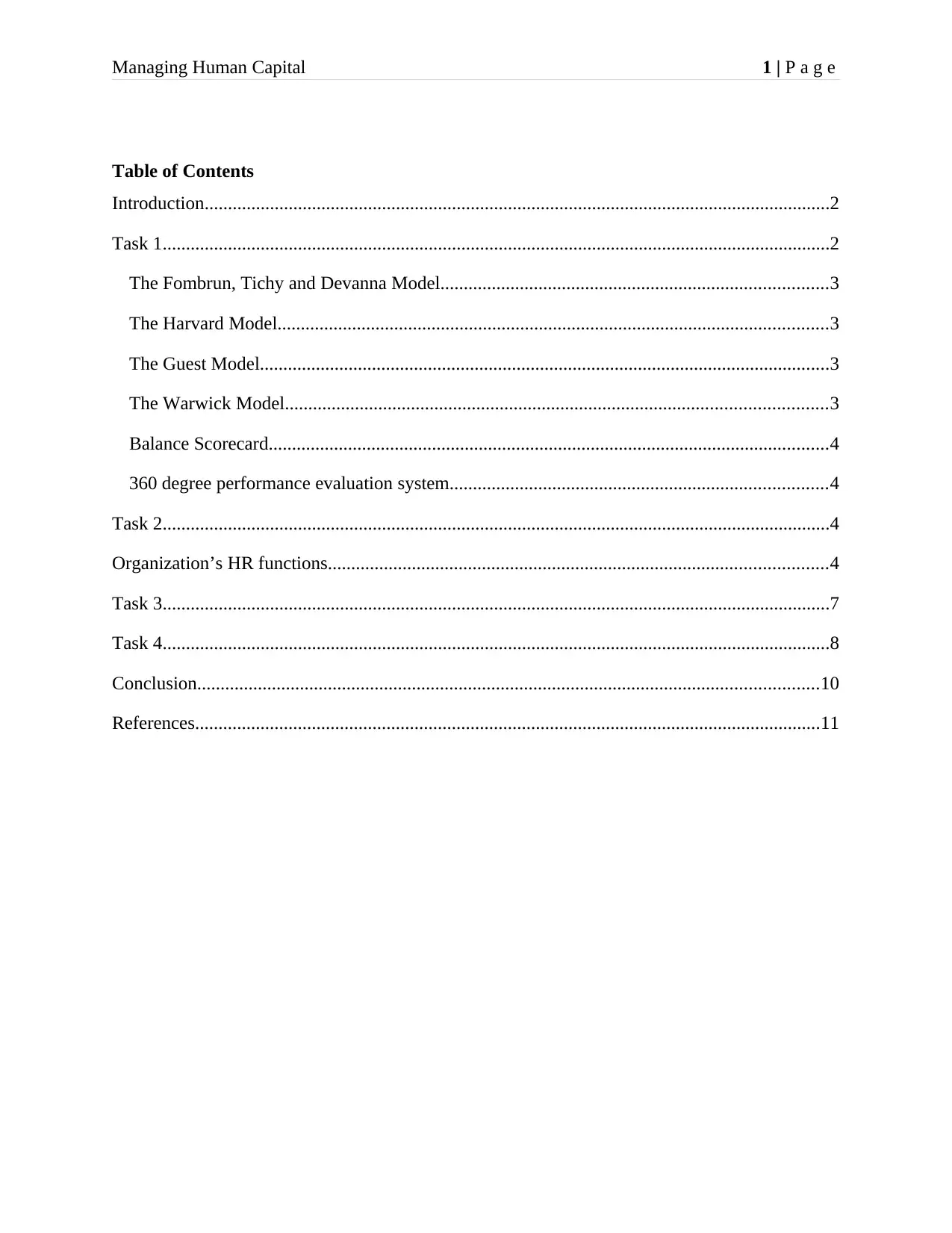
Managing Human Capital 1 | P a g e
Table of Contents
Introduction......................................................................................................................................2
Task 1...............................................................................................................................................2
The Fombrun, Tichy and Devanna Model...................................................................................3
The Harvard Model......................................................................................................................3
The Guest Model..........................................................................................................................3
The Warwick Model....................................................................................................................3
Balance Scorecard........................................................................................................................4
360 degree performance evaluation system.................................................................................4
Task 2...............................................................................................................................................4
Organization’s HR functions...........................................................................................................4
Task 3...............................................................................................................................................7
Task 4...............................................................................................................................................8
Conclusion.....................................................................................................................................10
References......................................................................................................................................11
Table of Contents
Introduction......................................................................................................................................2
Task 1...............................................................................................................................................2
The Fombrun, Tichy and Devanna Model...................................................................................3
The Harvard Model......................................................................................................................3
The Guest Model..........................................................................................................................3
The Warwick Model....................................................................................................................3
Balance Scorecard........................................................................................................................4
360 degree performance evaluation system.................................................................................4
Task 2...............................................................................................................................................4
Organization’s HR functions...........................................................................................................4
Task 3...............................................................................................................................................7
Task 4...............................................................................................................................................8
Conclusion.....................................................................................................................................10
References......................................................................................................................................11
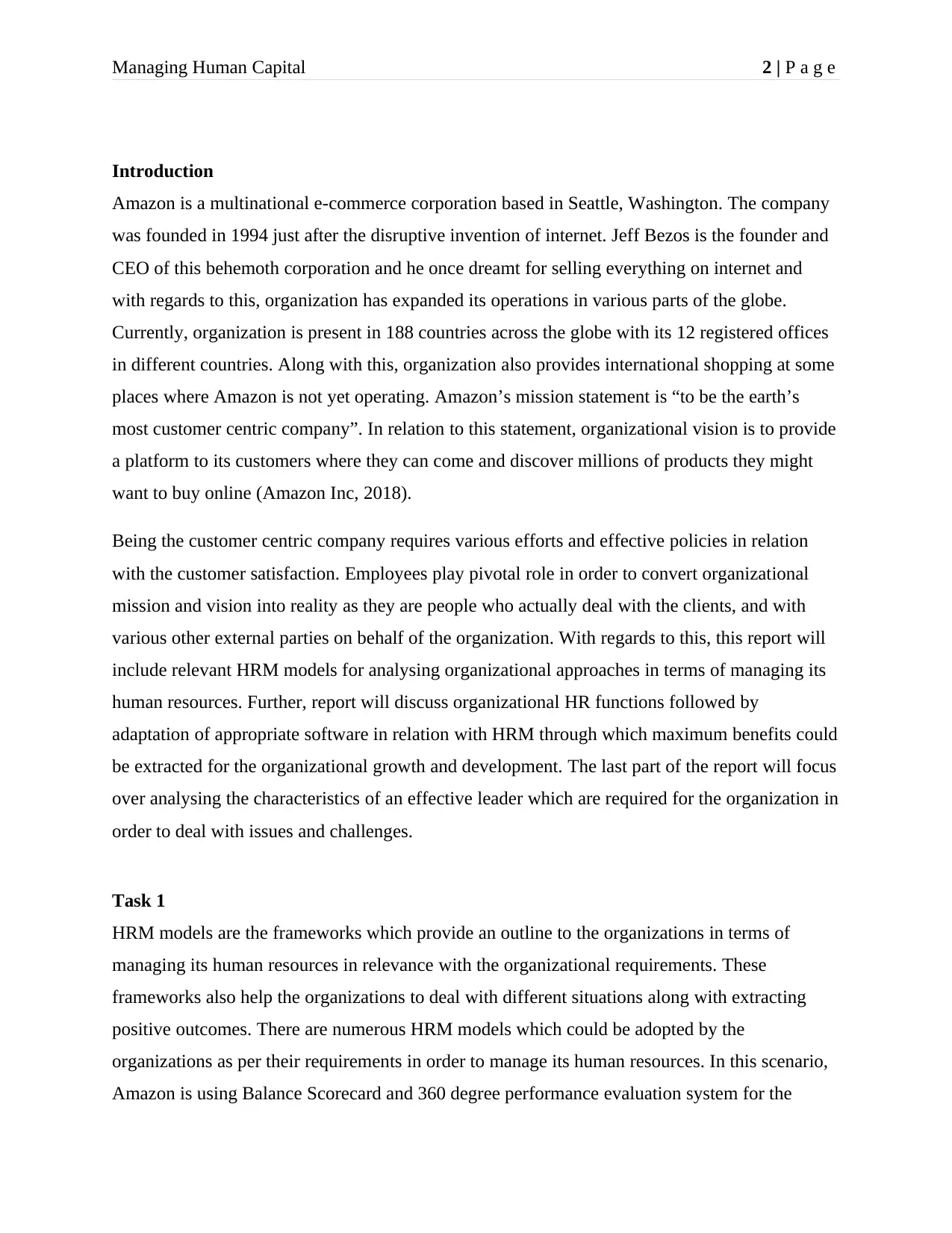
Managing Human Capital 2 | P a g e
Introduction
Amazon is a multinational e-commerce corporation based in Seattle, Washington. The company
was founded in 1994 just after the disruptive invention of internet. Jeff Bezos is the founder and
CEO of this behemoth corporation and he once dreamt for selling everything on internet and
with regards to this, organization has expanded its operations in various parts of the globe.
Currently, organization is present in 188 countries across the globe with its 12 registered offices
in different countries. Along with this, organization also provides international shopping at some
places where Amazon is not yet operating. Amazon’s mission statement is “to be the earth’s
most customer centric company”. In relation to this statement, organizational vision is to provide
a platform to its customers where they can come and discover millions of products they might
want to buy online (Amazon Inc, 2018).
Being the customer centric company requires various efforts and effective policies in relation
with the customer satisfaction. Employees play pivotal role in order to convert organizational
mission and vision into reality as they are people who actually deal with the clients, and with
various other external parties on behalf of the organization. With regards to this, this report will
include relevant HRM models for analysing organizational approaches in terms of managing its
human resources. Further, report will discuss organizational HR functions followed by
adaptation of appropriate software in relation with HRM through which maximum benefits could
be extracted for the organizational growth and development. The last part of the report will focus
over analysing the characteristics of an effective leader which are required for the organization in
order to deal with issues and challenges.
Task 1
HRM models are the frameworks which provide an outline to the organizations in terms of
managing its human resources in relevance with the organizational requirements. These
frameworks also help the organizations to deal with different situations along with extracting
positive outcomes. There are numerous HRM models which could be adopted by the
organizations as per their requirements in order to manage its human resources. In this scenario,
Amazon is using Balance Scorecard and 360 degree performance evaluation system for the
Introduction
Amazon is a multinational e-commerce corporation based in Seattle, Washington. The company
was founded in 1994 just after the disruptive invention of internet. Jeff Bezos is the founder and
CEO of this behemoth corporation and he once dreamt for selling everything on internet and
with regards to this, organization has expanded its operations in various parts of the globe.
Currently, organization is present in 188 countries across the globe with its 12 registered offices
in different countries. Along with this, organization also provides international shopping at some
places where Amazon is not yet operating. Amazon’s mission statement is “to be the earth’s
most customer centric company”. In relation to this statement, organizational vision is to provide
a platform to its customers where they can come and discover millions of products they might
want to buy online (Amazon Inc, 2018).
Being the customer centric company requires various efforts and effective policies in relation
with the customer satisfaction. Employees play pivotal role in order to convert organizational
mission and vision into reality as they are people who actually deal with the clients, and with
various other external parties on behalf of the organization. With regards to this, this report will
include relevant HRM models for analysing organizational approaches in terms of managing its
human resources. Further, report will discuss organizational HR functions followed by
adaptation of appropriate software in relation with HRM through which maximum benefits could
be extracted for the organizational growth and development. The last part of the report will focus
over analysing the characteristics of an effective leader which are required for the organization in
order to deal with issues and challenges.
Task 1
HRM models are the frameworks which provide an outline to the organizations in terms of
managing its human resources in relevance with the organizational requirements. These
frameworks also help the organizations to deal with different situations along with extracting
positive outcomes. There are numerous HRM models which could be adopted by the
organizations as per their requirements in order to manage its human resources. In this scenario,
Amazon is using Balance Scorecard and 360 degree performance evaluation system for the
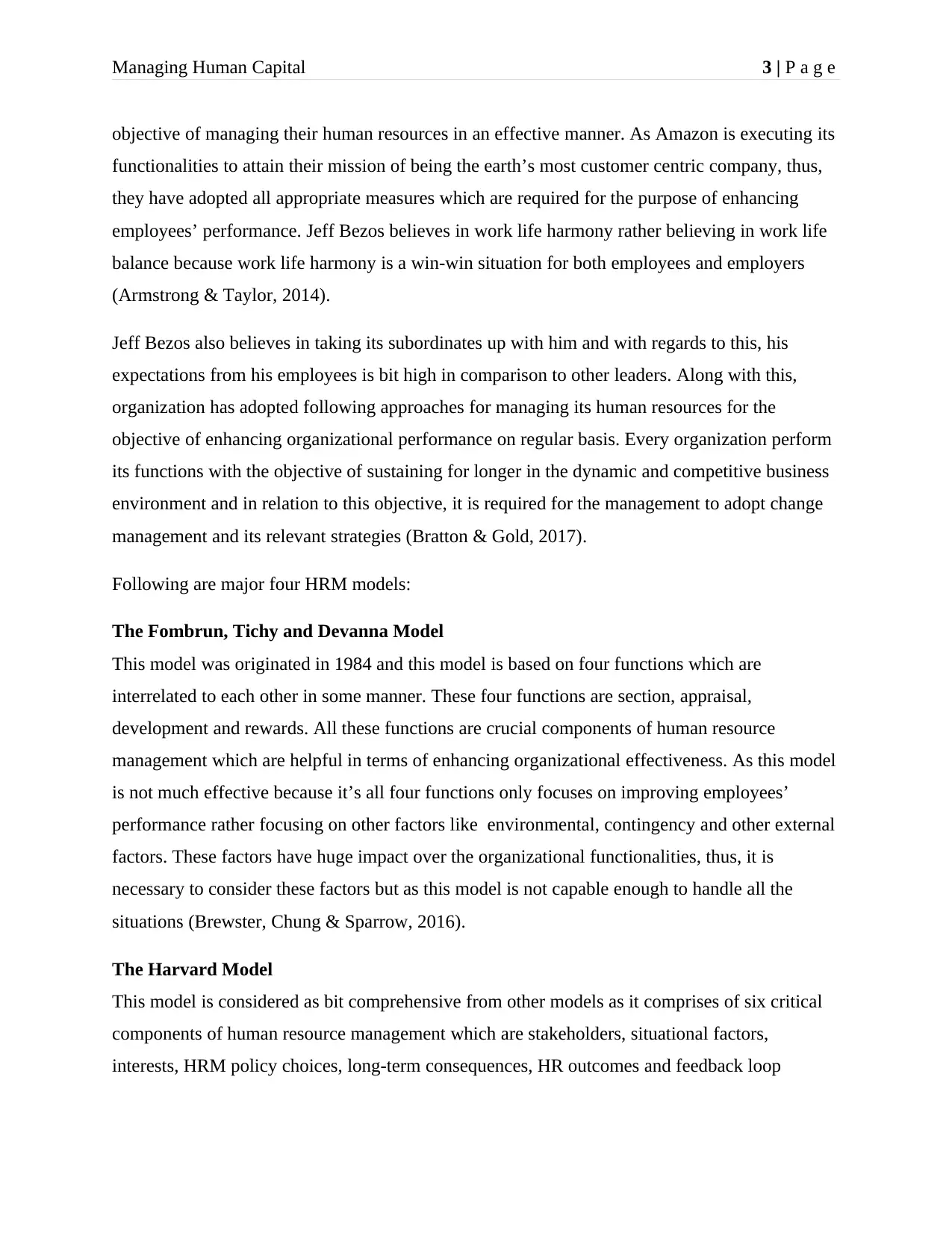
Managing Human Capital 3 | P a g e
objective of managing their human resources in an effective manner. As Amazon is executing its
functionalities to attain their mission of being the earth’s most customer centric company, thus,
they have adopted all appropriate measures which are required for the purpose of enhancing
employees’ performance. Jeff Bezos believes in work life harmony rather believing in work life
balance because work life harmony is a win-win situation for both employees and employers
(Armstrong & Taylor, 2014).
Jeff Bezos also believes in taking its subordinates up with him and with regards to this, his
expectations from his employees is bit high in comparison to other leaders. Along with this,
organization has adopted following approaches for managing its human resources for the
objective of enhancing organizational performance on regular basis. Every organization perform
its functions with the objective of sustaining for longer in the dynamic and competitive business
environment and in relation to this objective, it is required for the management to adopt change
management and its relevant strategies (Bratton & Gold, 2017).
Following are major four HRM models:
The Fombrun, Tichy and Devanna Model
This model was originated in 1984 and this model is based on four functions which are
interrelated to each other in some manner. These four functions are section, appraisal,
development and rewards. All these functions are crucial components of human resource
management which are helpful in terms of enhancing organizational effectiveness. As this model
is not much effective because it’s all four functions only focuses on improving employees’
performance rather focusing on other factors like environmental, contingency and other external
factors. These factors have huge impact over the organizational functionalities, thus, it is
necessary to consider these factors but as this model is not capable enough to handle all the
situations (Brewster, Chung & Sparrow, 2016).
The Harvard Model
This model is considered as bit comprehensive from other models as it comprises of six critical
components of human resource management which are stakeholders, situational factors,
interests, HRM policy choices, long-term consequences, HR outcomes and feedback loop
objective of managing their human resources in an effective manner. As Amazon is executing its
functionalities to attain their mission of being the earth’s most customer centric company, thus,
they have adopted all appropriate measures which are required for the purpose of enhancing
employees’ performance. Jeff Bezos believes in work life harmony rather believing in work life
balance because work life harmony is a win-win situation for both employees and employers
(Armstrong & Taylor, 2014).
Jeff Bezos also believes in taking its subordinates up with him and with regards to this, his
expectations from his employees is bit high in comparison to other leaders. Along with this,
organization has adopted following approaches for managing its human resources for the
objective of enhancing organizational performance on regular basis. Every organization perform
its functions with the objective of sustaining for longer in the dynamic and competitive business
environment and in relation to this objective, it is required for the management to adopt change
management and its relevant strategies (Bratton & Gold, 2017).
Following are major four HRM models:
The Fombrun, Tichy and Devanna Model
This model was originated in 1984 and this model is based on four functions which are
interrelated to each other in some manner. These four functions are section, appraisal,
development and rewards. All these functions are crucial components of human resource
management which are helpful in terms of enhancing organizational effectiveness. As this model
is not much effective because it’s all four functions only focuses on improving employees’
performance rather focusing on other factors like environmental, contingency and other external
factors. These factors have huge impact over the organizational functionalities, thus, it is
necessary to consider these factors but as this model is not capable enough to handle all the
situations (Brewster, Chung & Sparrow, 2016).
The Harvard Model
This model is considered as bit comprehensive from other models as it comprises of six critical
components of human resource management which are stakeholders, situational factors,
interests, HRM policy choices, long-term consequences, HR outcomes and feedback loop
Secure Best Marks with AI Grader
Need help grading? Try our AI Grader for instant feedback on your assignments.
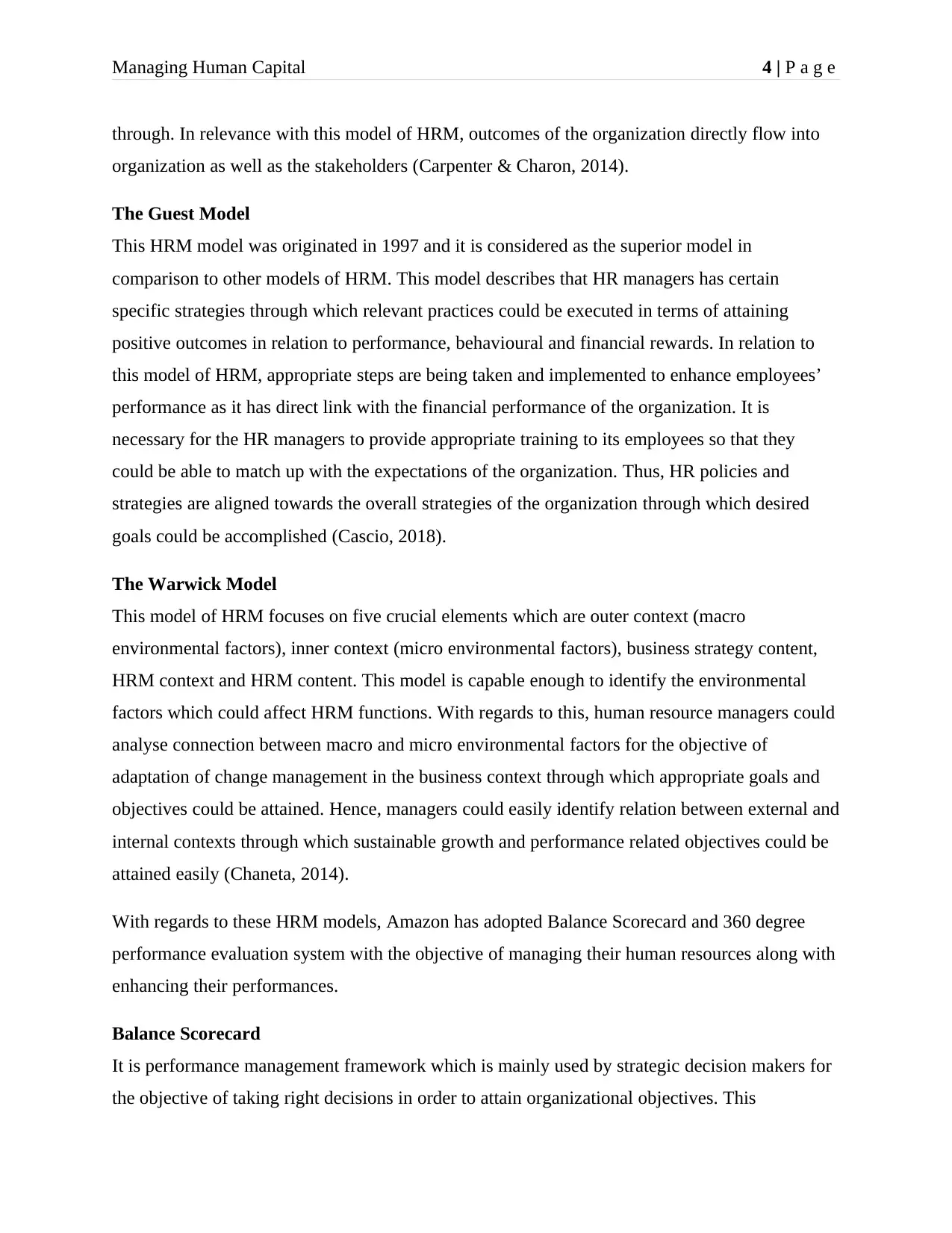
Managing Human Capital 4 | P a g e
through. In relevance with this model of HRM, outcomes of the organization directly flow into
organization as well as the stakeholders (Carpenter & Charon, 2014).
The Guest Model
This HRM model was originated in 1997 and it is considered as the superior model in
comparison to other models of HRM. This model describes that HR managers has certain
specific strategies through which relevant practices could be executed in terms of attaining
positive outcomes in relation to performance, behavioural and financial rewards. In relation to
this model of HRM, appropriate steps are being taken and implemented to enhance employees’
performance as it has direct link with the financial performance of the organization. It is
necessary for the HR managers to provide appropriate training to its employees so that they
could be able to match up with the expectations of the organization. Thus, HR policies and
strategies are aligned towards the overall strategies of the organization through which desired
goals could be accomplished (Cascio, 2018).
The Warwick Model
This model of HRM focuses on five crucial elements which are outer context (macro
environmental factors), inner context (micro environmental factors), business strategy content,
HRM context and HRM content. This model is capable enough to identify the environmental
factors which could affect HRM functions. With regards to this, human resource managers could
analyse connection between macro and micro environmental factors for the objective of
adaptation of change management in the business context through which appropriate goals and
objectives could be attained. Hence, managers could easily identify relation between external and
internal contexts through which sustainable growth and performance related objectives could be
attained easily (Chaneta, 2014).
With regards to these HRM models, Amazon has adopted Balance Scorecard and 360 degree
performance evaluation system with the objective of managing their human resources along with
enhancing their performances.
Balance Scorecard
It is performance management framework which is mainly used by strategic decision makers for
the objective of taking right decisions in order to attain organizational objectives. This
through. In relevance with this model of HRM, outcomes of the organization directly flow into
organization as well as the stakeholders (Carpenter & Charon, 2014).
The Guest Model
This HRM model was originated in 1997 and it is considered as the superior model in
comparison to other models of HRM. This model describes that HR managers has certain
specific strategies through which relevant practices could be executed in terms of attaining
positive outcomes in relation to performance, behavioural and financial rewards. In relation to
this model of HRM, appropriate steps are being taken and implemented to enhance employees’
performance as it has direct link with the financial performance of the organization. It is
necessary for the HR managers to provide appropriate training to its employees so that they
could be able to match up with the expectations of the organization. Thus, HR policies and
strategies are aligned towards the overall strategies of the organization through which desired
goals could be accomplished (Cascio, 2018).
The Warwick Model
This model of HRM focuses on five crucial elements which are outer context (macro
environmental factors), inner context (micro environmental factors), business strategy content,
HRM context and HRM content. This model is capable enough to identify the environmental
factors which could affect HRM functions. With regards to this, human resource managers could
analyse connection between macro and micro environmental factors for the objective of
adaptation of change management in the business context through which appropriate goals and
objectives could be attained. Hence, managers could easily identify relation between external and
internal contexts through which sustainable growth and performance related objectives could be
attained easily (Chaneta, 2014).
With regards to these HRM models, Amazon has adopted Balance Scorecard and 360 degree
performance evaluation system with the objective of managing their human resources along with
enhancing their performances.
Balance Scorecard
It is performance management framework which is mainly used by strategic decision makers for
the objective of taking right decisions in order to attain organizational objectives. This

Managing Human Capital 5 | P a g e
framework consists of certain strategic goals along with certain methods of monitoring
frameworks in relation with the attainment of strategic goals. This framework is designed in the
form to analyse the organizational performance from both internal as well as external
perspective. In this framework, employees’ performance is evaluated on the basis of customer
perspective, internal-business processes, learning and growth and financials. Every employee’s
performance is evaluated on the basis of these four elements and further, appropriate measures
are being taken by the managers of HRM to enhance their performance. This ultimately helps the
organization to boost up their performance along with gaining positive outcomes (Chiang &
Suen, 2015).
360 degree performance evaluation system
This framework is also known as multi-rater feedback system and under this framework, an
employee gets feedback from his subordinates, supervisors, colleagues, and by the performance
evaluator in respect to the performance, behaviour, etc. For those employees who deal with the
clients on organizational behaviour, for them, feedbacks from external stakeholders are also
taken to evaluate their performance. As Amazon is a customer centric company and their
primary motive is to help their customers in every possible manner and in relation to this, it is
necessary for the organization to evaluate their employees’ performance and behaviour so that if
any gap exists between the organizational expectations and employees’ performance, appropriate
steps could be taken in time in order to enhance their performance along with enhancing
customer satisfaction (Craig, 2015).
Task 2
Organization’s HR functions
Human resource management plays a critical role in the success of any business. The employees
associated with the business are essential for business’s growth. Therefore it is important to
ensure higher levels of employee satisfaction, retention and growth in the organization
(Armstrong & Talor, 2014). The first step to effective human resource management is
recruitment and selection of competent employees within the business. Recruiting proficient
employees creates a solid backbone for Amazon which leads to sustainable growth in the future.
framework consists of certain strategic goals along with certain methods of monitoring
frameworks in relation with the attainment of strategic goals. This framework is designed in the
form to analyse the organizational performance from both internal as well as external
perspective. In this framework, employees’ performance is evaluated on the basis of customer
perspective, internal-business processes, learning and growth and financials. Every employee’s
performance is evaluated on the basis of these four elements and further, appropriate measures
are being taken by the managers of HRM to enhance their performance. This ultimately helps the
organization to boost up their performance along with gaining positive outcomes (Chiang &
Suen, 2015).
360 degree performance evaluation system
This framework is also known as multi-rater feedback system and under this framework, an
employee gets feedback from his subordinates, supervisors, colleagues, and by the performance
evaluator in respect to the performance, behaviour, etc. For those employees who deal with the
clients on organizational behaviour, for them, feedbacks from external stakeholders are also
taken to evaluate their performance. As Amazon is a customer centric company and their
primary motive is to help their customers in every possible manner and in relation to this, it is
necessary for the organization to evaluate their employees’ performance and behaviour so that if
any gap exists between the organizational expectations and employees’ performance, appropriate
steps could be taken in time in order to enhance their performance along with enhancing
customer satisfaction (Craig, 2015).
Task 2
Organization’s HR functions
Human resource management plays a critical role in the success of any business. The employees
associated with the business are essential for business’s growth. Therefore it is important to
ensure higher levels of employee satisfaction, retention and growth in the organization
(Armstrong & Talor, 2014). The first step to effective human resource management is
recruitment and selection of competent employees within the business. Recruiting proficient
employees creates a solid backbone for Amazon which leads to sustainable growth in the future.
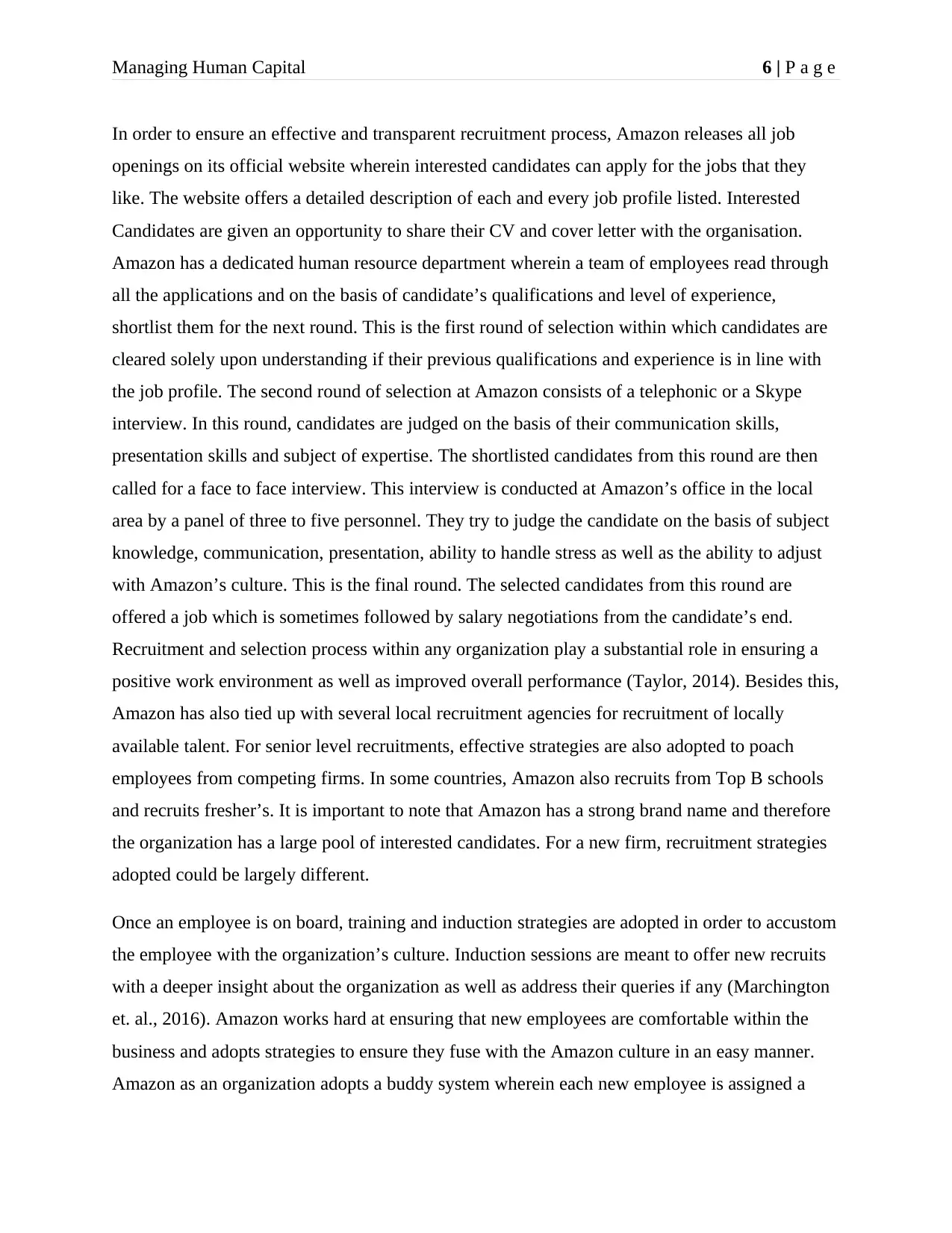
Managing Human Capital 6 | P a g e
In order to ensure an effective and transparent recruitment process, Amazon releases all job
openings on its official website wherein interested candidates can apply for the jobs that they
like. The website offers a detailed description of each and every job profile listed. Interested
Candidates are given an opportunity to share their CV and cover letter with the organisation.
Amazon has a dedicated human resource department wherein a team of employees read through
all the applications and on the basis of candidate’s qualifications and level of experience,
shortlist them for the next round. This is the first round of selection within which candidates are
cleared solely upon understanding if their previous qualifications and experience is in line with
the job profile. The second round of selection at Amazon consists of a telephonic or a Skype
interview. In this round, candidates are judged on the basis of their communication skills,
presentation skills and subject of expertise. The shortlisted candidates from this round are then
called for a face to face interview. This interview is conducted at Amazon’s office in the local
area by a panel of three to five personnel. They try to judge the candidate on the basis of subject
knowledge, communication, presentation, ability to handle stress as well as the ability to adjust
with Amazon’s culture. This is the final round. The selected candidates from this round are
offered a job which is sometimes followed by salary negotiations from the candidate’s end.
Recruitment and selection process within any organization play a substantial role in ensuring a
positive work environment as well as improved overall performance (Taylor, 2014). Besides this,
Amazon has also tied up with several local recruitment agencies for recruitment of locally
available talent. For senior level recruitments, effective strategies are also adopted to poach
employees from competing firms. In some countries, Amazon also recruits from Top B schools
and recruits fresher’s. It is important to note that Amazon has a strong brand name and therefore
the organization has a large pool of interested candidates. For a new firm, recruitment strategies
adopted could be largely different.
Once an employee is on board, training and induction strategies are adopted in order to accustom
the employee with the organization’s culture. Induction sessions are meant to offer new recruits
with a deeper insight about the organization as well as address their queries if any (Marchington
et. al., 2016). Amazon works hard at ensuring that new employees are comfortable within the
business and adopts strategies to ensure they fuse with the Amazon culture in an easy manner.
Amazon as an organization adopts a buddy system wherein each new employee is assigned a
In order to ensure an effective and transparent recruitment process, Amazon releases all job
openings on its official website wherein interested candidates can apply for the jobs that they
like. The website offers a detailed description of each and every job profile listed. Interested
Candidates are given an opportunity to share their CV and cover letter with the organisation.
Amazon has a dedicated human resource department wherein a team of employees read through
all the applications and on the basis of candidate’s qualifications and level of experience,
shortlist them for the next round. This is the first round of selection within which candidates are
cleared solely upon understanding if their previous qualifications and experience is in line with
the job profile. The second round of selection at Amazon consists of a telephonic or a Skype
interview. In this round, candidates are judged on the basis of their communication skills,
presentation skills and subject of expertise. The shortlisted candidates from this round are then
called for a face to face interview. This interview is conducted at Amazon’s office in the local
area by a panel of three to five personnel. They try to judge the candidate on the basis of subject
knowledge, communication, presentation, ability to handle stress as well as the ability to adjust
with Amazon’s culture. This is the final round. The selected candidates from this round are
offered a job which is sometimes followed by salary negotiations from the candidate’s end.
Recruitment and selection process within any organization play a substantial role in ensuring a
positive work environment as well as improved overall performance (Taylor, 2014). Besides this,
Amazon has also tied up with several local recruitment agencies for recruitment of locally
available talent. For senior level recruitments, effective strategies are also adopted to poach
employees from competing firms. In some countries, Amazon also recruits from Top B schools
and recruits fresher’s. It is important to note that Amazon has a strong brand name and therefore
the organization has a large pool of interested candidates. For a new firm, recruitment strategies
adopted could be largely different.
Once an employee is on board, training and induction strategies are adopted in order to accustom
the employee with the organization’s culture. Induction sessions are meant to offer new recruits
with a deeper insight about the organization as well as address their queries if any (Marchington
et. al., 2016). Amazon works hard at ensuring that new employees are comfortable within the
business and adopts strategies to ensure they fuse with the Amazon culture in an easy manner.
Amazon as an organization adopts a buddy system wherein each new employee is assigned a
Paraphrase This Document
Need a fresh take? Get an instant paraphrase of this document with our AI Paraphraser
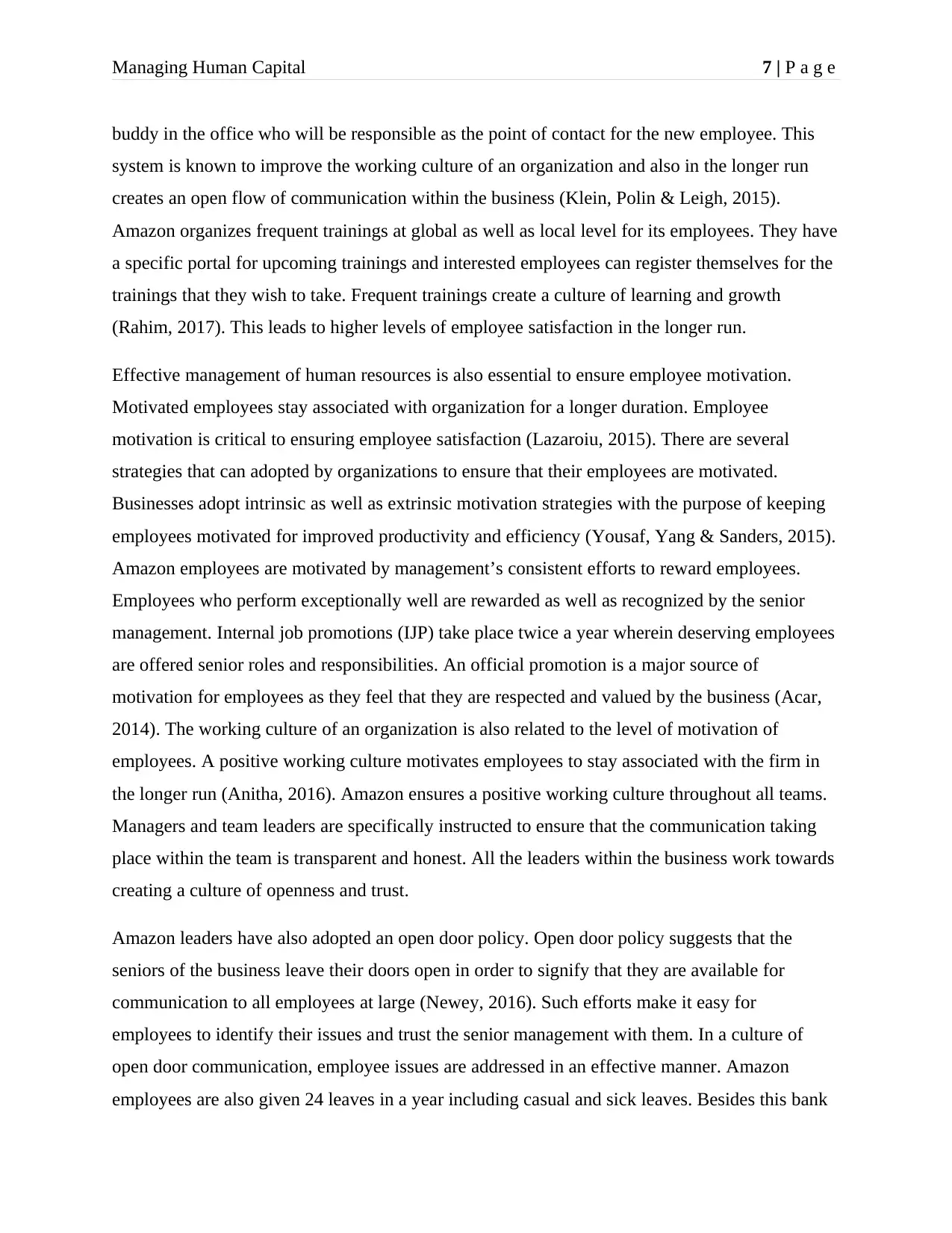
Managing Human Capital 7 | P a g e
buddy in the office who will be responsible as the point of contact for the new employee. This
system is known to improve the working culture of an organization and also in the longer run
creates an open flow of communication within the business (Klein, Polin & Leigh, 2015).
Amazon organizes frequent trainings at global as well as local level for its employees. They have
a specific portal for upcoming trainings and interested employees can register themselves for the
trainings that they wish to take. Frequent trainings create a culture of learning and growth
(Rahim, 2017). This leads to higher levels of employee satisfaction in the longer run.
Effective management of human resources is also essential to ensure employee motivation.
Motivated employees stay associated with organization for a longer duration. Employee
motivation is critical to ensuring employee satisfaction (Lazaroiu, 2015). There are several
strategies that can adopted by organizations to ensure that their employees are motivated.
Businesses adopt intrinsic as well as extrinsic motivation strategies with the purpose of keeping
employees motivated for improved productivity and efficiency (Yousaf, Yang & Sanders, 2015).
Amazon employees are motivated by management’s consistent efforts to reward employees.
Employees who perform exceptionally well are rewarded as well as recognized by the senior
management. Internal job promotions (IJP) take place twice a year wherein deserving employees
are offered senior roles and responsibilities. An official promotion is a major source of
motivation for employees as they feel that they are respected and valued by the business (Acar,
2014). The working culture of an organization is also related to the level of motivation of
employees. A positive working culture motivates employees to stay associated with the firm in
the longer run (Anitha, 2016). Amazon ensures a positive working culture throughout all teams.
Managers and team leaders are specifically instructed to ensure that the communication taking
place within the team is transparent and honest. All the leaders within the business work towards
creating a culture of openness and trust.
Amazon leaders have also adopted an open door policy. Open door policy suggests that the
seniors of the business leave their doors open in order to signify that they are available for
communication to all employees at large (Newey, 2016). Such efforts make it easy for
employees to identify their issues and trust the senior management with them. In a culture of
open door communication, employee issues are addressed in an effective manner. Amazon
employees are also given 24 leaves in a year including casual and sick leaves. Besides this bank
buddy in the office who will be responsible as the point of contact for the new employee. This
system is known to improve the working culture of an organization and also in the longer run
creates an open flow of communication within the business (Klein, Polin & Leigh, 2015).
Amazon organizes frequent trainings at global as well as local level for its employees. They have
a specific portal for upcoming trainings and interested employees can register themselves for the
trainings that they wish to take. Frequent trainings create a culture of learning and growth
(Rahim, 2017). This leads to higher levels of employee satisfaction in the longer run.
Effective management of human resources is also essential to ensure employee motivation.
Motivated employees stay associated with organization for a longer duration. Employee
motivation is critical to ensuring employee satisfaction (Lazaroiu, 2015). There are several
strategies that can adopted by organizations to ensure that their employees are motivated.
Businesses adopt intrinsic as well as extrinsic motivation strategies with the purpose of keeping
employees motivated for improved productivity and efficiency (Yousaf, Yang & Sanders, 2015).
Amazon employees are motivated by management’s consistent efforts to reward employees.
Employees who perform exceptionally well are rewarded as well as recognized by the senior
management. Internal job promotions (IJP) take place twice a year wherein deserving employees
are offered senior roles and responsibilities. An official promotion is a major source of
motivation for employees as they feel that they are respected and valued by the business (Acar,
2014). The working culture of an organization is also related to the level of motivation of
employees. A positive working culture motivates employees to stay associated with the firm in
the longer run (Anitha, 2016). Amazon ensures a positive working culture throughout all teams.
Managers and team leaders are specifically instructed to ensure that the communication taking
place within the team is transparent and honest. All the leaders within the business work towards
creating a culture of openness and trust.
Amazon leaders have also adopted an open door policy. Open door policy suggests that the
seniors of the business leave their doors open in order to signify that they are available for
communication to all employees at large (Newey, 2016). Such efforts make it easy for
employees to identify their issues and trust the senior management with them. In a culture of
open door communication, employee issues are addressed in an effective manner. Amazon
employees are also given 24 leaves in a year including casual and sick leaves. Besides this bank
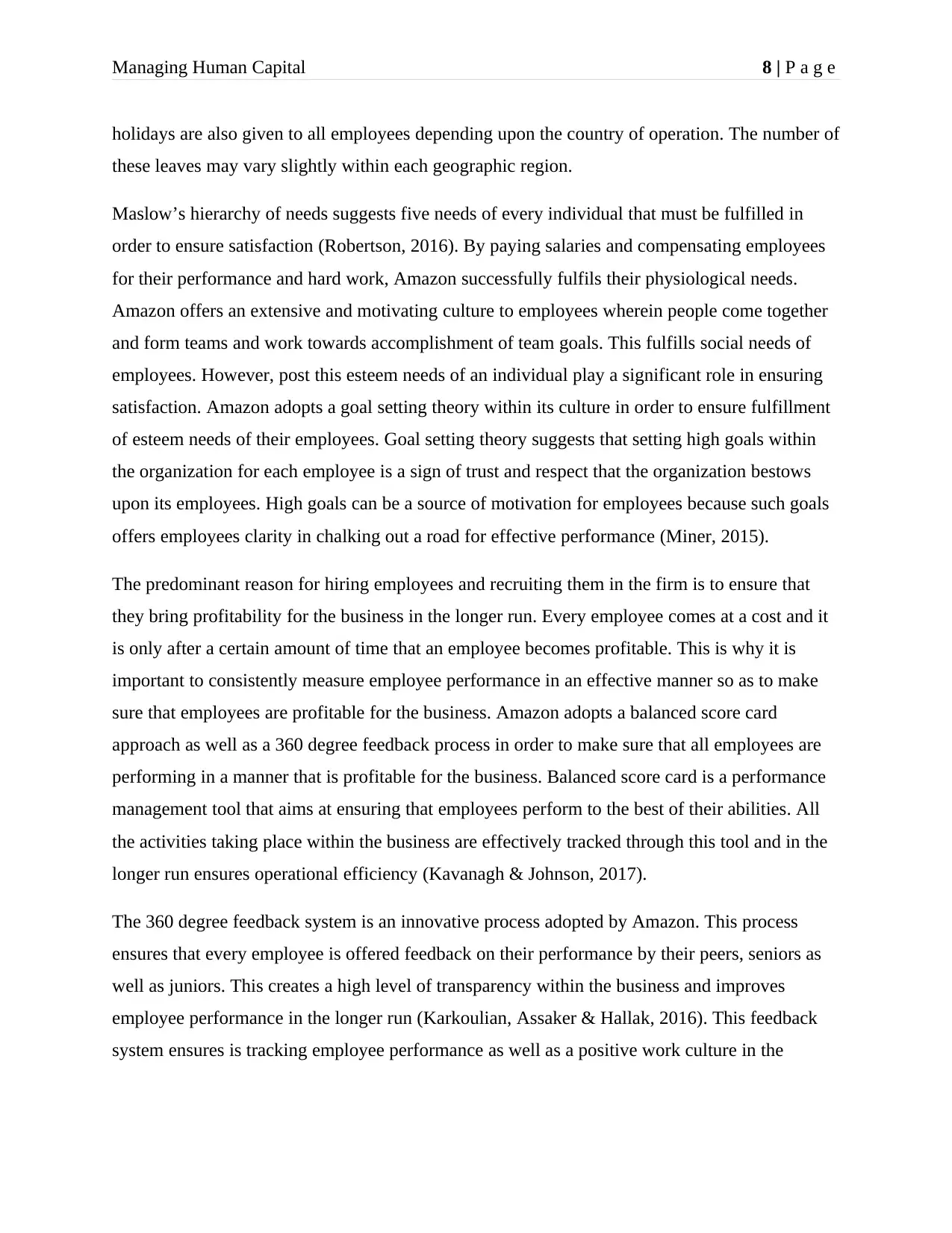
Managing Human Capital 8 | P a g e
holidays are also given to all employees depending upon the country of operation. The number of
these leaves may vary slightly within each geographic region.
Maslow’s hierarchy of needs suggests five needs of every individual that must be fulfilled in
order to ensure satisfaction (Robertson, 2016). By paying salaries and compensating employees
for their performance and hard work, Amazon successfully fulfils their physiological needs.
Amazon offers an extensive and motivating culture to employees wherein people come together
and form teams and work towards accomplishment of team goals. This fulfills social needs of
employees. However, post this esteem needs of an individual play a significant role in ensuring
satisfaction. Amazon adopts a goal setting theory within its culture in order to ensure fulfillment
of esteem needs of their employees. Goal setting theory suggests that setting high goals within
the organization for each employee is a sign of trust and respect that the organization bestows
upon its employees. High goals can be a source of motivation for employees because such goals
offers employees clarity in chalking out a road for effective performance (Miner, 2015).
The predominant reason for hiring employees and recruiting them in the firm is to ensure that
they bring profitability for the business in the longer run. Every employee comes at a cost and it
is only after a certain amount of time that an employee becomes profitable. This is why it is
important to consistently measure employee performance in an effective manner so as to make
sure that employees are profitable for the business. Amazon adopts a balanced score card
approach as well as a 360 degree feedback process in order to make sure that all employees are
performing in a manner that is profitable for the business. Balanced score card is a performance
management tool that aims at ensuring that employees perform to the best of their abilities. All
the activities taking place within the business are effectively tracked through this tool and in the
longer run ensures operational efficiency (Kavanagh & Johnson, 2017).
The 360 degree feedback system is an innovative process adopted by Amazon. This process
ensures that every employee is offered feedback on their performance by their peers, seniors as
well as juniors. This creates a high level of transparency within the business and improves
employee performance in the longer run (Karkoulian, Assaker & Hallak, 2016). This feedback
system ensures is tracking employee performance as well as a positive work culture in the
holidays are also given to all employees depending upon the country of operation. The number of
these leaves may vary slightly within each geographic region.
Maslow’s hierarchy of needs suggests five needs of every individual that must be fulfilled in
order to ensure satisfaction (Robertson, 2016). By paying salaries and compensating employees
for their performance and hard work, Amazon successfully fulfils their physiological needs.
Amazon offers an extensive and motivating culture to employees wherein people come together
and form teams and work towards accomplishment of team goals. This fulfills social needs of
employees. However, post this esteem needs of an individual play a significant role in ensuring
satisfaction. Amazon adopts a goal setting theory within its culture in order to ensure fulfillment
of esteem needs of their employees. Goal setting theory suggests that setting high goals within
the organization for each employee is a sign of trust and respect that the organization bestows
upon its employees. High goals can be a source of motivation for employees because such goals
offers employees clarity in chalking out a road for effective performance (Miner, 2015).
The predominant reason for hiring employees and recruiting them in the firm is to ensure that
they bring profitability for the business in the longer run. Every employee comes at a cost and it
is only after a certain amount of time that an employee becomes profitable. This is why it is
important to consistently measure employee performance in an effective manner so as to make
sure that employees are profitable for the business. Amazon adopts a balanced score card
approach as well as a 360 degree feedback process in order to make sure that all employees are
performing in a manner that is profitable for the business. Balanced score card is a performance
management tool that aims at ensuring that employees perform to the best of their abilities. All
the activities taking place within the business are effectively tracked through this tool and in the
longer run ensures operational efficiency (Kavanagh & Johnson, 2017).
The 360 degree feedback system is an innovative process adopted by Amazon. This process
ensures that every employee is offered feedback on their performance by their peers, seniors as
well as juniors. This creates a high level of transparency within the business and improves
employee performance in the longer run (Karkoulian, Assaker & Hallak, 2016). This feedback
system ensures is tracking employee performance as well as a positive work culture in the
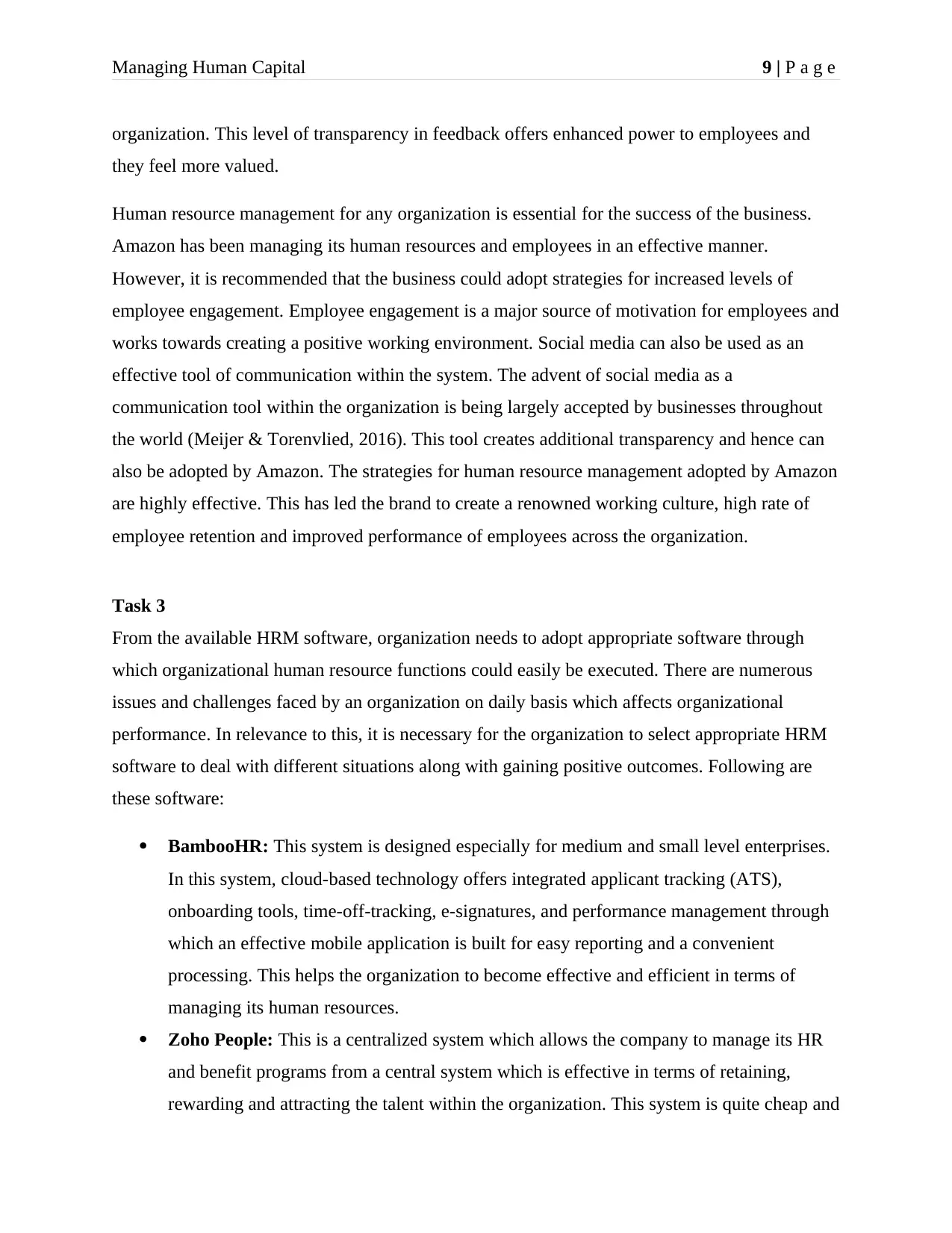
Managing Human Capital 9 | P a g e
organization. This level of transparency in feedback offers enhanced power to employees and
they feel more valued.
Human resource management for any organization is essential for the success of the business.
Amazon has been managing its human resources and employees in an effective manner.
However, it is recommended that the business could adopt strategies for increased levels of
employee engagement. Employee engagement is a major source of motivation for employees and
works towards creating a positive working environment. Social media can also be used as an
effective tool of communication within the system. The advent of social media as a
communication tool within the organization is being largely accepted by businesses throughout
the world (Meijer & Torenvlied, 2016). This tool creates additional transparency and hence can
also be adopted by Amazon. The strategies for human resource management adopted by Amazon
are highly effective. This has led the brand to create a renowned working culture, high rate of
employee retention and improved performance of employees across the organization.
Task 3
From the available HRM software, organization needs to adopt appropriate software through
which organizational human resource functions could easily be executed. There are numerous
issues and challenges faced by an organization on daily basis which affects organizational
performance. In relevance to this, it is necessary for the organization to select appropriate HRM
software to deal with different situations along with gaining positive outcomes. Following are
these software:
BambooHR: This system is designed especially for medium and small level enterprises.
In this system, cloud-based technology offers integrated applicant tracking (ATS),
onboarding tools, time-off-tracking, e-signatures, and performance management through
which an effective mobile application is built for easy reporting and a convenient
processing. This helps the organization to become effective and efficient in terms of
managing its human resources.
Zoho People: This is a centralized system which allows the company to manage its HR
and benefit programs from a central system which is effective in terms of retaining,
rewarding and attracting the talent within the organization. This system is quite cheap and
organization. This level of transparency in feedback offers enhanced power to employees and
they feel more valued.
Human resource management for any organization is essential for the success of the business.
Amazon has been managing its human resources and employees in an effective manner.
However, it is recommended that the business could adopt strategies for increased levels of
employee engagement. Employee engagement is a major source of motivation for employees and
works towards creating a positive working environment. Social media can also be used as an
effective tool of communication within the system. The advent of social media as a
communication tool within the organization is being largely accepted by businesses throughout
the world (Meijer & Torenvlied, 2016). This tool creates additional transparency and hence can
also be adopted by Amazon. The strategies for human resource management adopted by Amazon
are highly effective. This has led the brand to create a renowned working culture, high rate of
employee retention and improved performance of employees across the organization.
Task 3
From the available HRM software, organization needs to adopt appropriate software through
which organizational human resource functions could easily be executed. There are numerous
issues and challenges faced by an organization on daily basis which affects organizational
performance. In relevance to this, it is necessary for the organization to select appropriate HRM
software to deal with different situations along with gaining positive outcomes. Following are
these software:
BambooHR: This system is designed especially for medium and small level enterprises.
In this system, cloud-based technology offers integrated applicant tracking (ATS),
onboarding tools, time-off-tracking, e-signatures, and performance management through
which an effective mobile application is built for easy reporting and a convenient
processing. This helps the organization to become effective and efficient in terms of
managing its human resources.
Zoho People: This is a centralized system which allows the company to manage its HR
and benefit programs from a central system which is effective in terms of retaining,
rewarding and attracting the talent within the organization. This system is quite cheap and
Secure Best Marks with AI Grader
Need help grading? Try our AI Grader for instant feedback on your assignments.
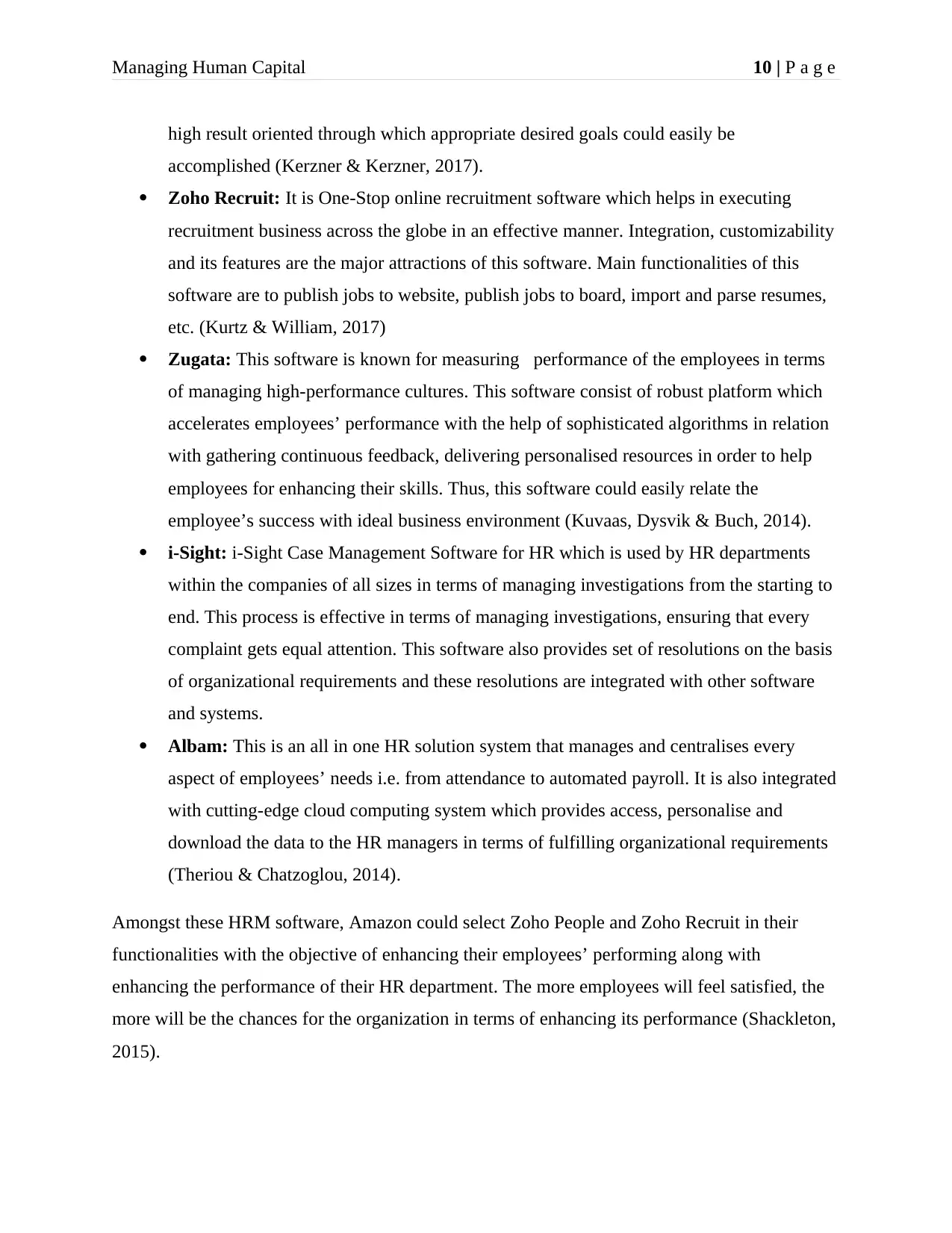
Managing Human Capital 10 | P a g e
high result oriented through which appropriate desired goals could easily be
accomplished (Kerzner & Kerzner, 2017).
Zoho Recruit: It is One-Stop online recruitment software which helps in executing
recruitment business across the globe in an effective manner. Integration, customizability
and its features are the major attractions of this software. Main functionalities of this
software are to publish jobs to website, publish jobs to board, import and parse resumes,
etc. (Kurtz & William, 2017)
Zugata: This software is known for measuring performance of the employees in terms
of managing high-performance cultures. This software consist of robust platform which
accelerates employees’ performance with the help of sophisticated algorithms in relation
with gathering continuous feedback, delivering personalised resources in order to help
employees for enhancing their skills. Thus, this software could easily relate the
employee’s success with ideal business environment (Kuvaas, Dysvik & Buch, 2014).
i-Sight: i-Sight Case Management Software for HR which is used by HR departments
within the companies of all sizes in terms of managing investigations from the starting to
end. This process is effective in terms of managing investigations, ensuring that every
complaint gets equal attention. This software also provides set of resolutions on the basis
of organizational requirements and these resolutions are integrated with other software
and systems.
Albam: This is an all in one HR solution system that manages and centralises every
aspect of employees’ needs i.e. from attendance to automated payroll. It is also integrated
with cutting-edge cloud computing system which provides access, personalise and
download the data to the HR managers in terms of fulfilling organizational requirements
(Theriou & Chatzoglou, 2014).
Amongst these HRM software, Amazon could select Zoho People and Zoho Recruit in their
functionalities with the objective of enhancing their employees’ performing along with
enhancing the performance of their HR department. The more employees will feel satisfied, the
more will be the chances for the organization in terms of enhancing its performance (Shackleton,
2015).
high result oriented through which appropriate desired goals could easily be
accomplished (Kerzner & Kerzner, 2017).
Zoho Recruit: It is One-Stop online recruitment software which helps in executing
recruitment business across the globe in an effective manner. Integration, customizability
and its features are the major attractions of this software. Main functionalities of this
software are to publish jobs to website, publish jobs to board, import and parse resumes,
etc. (Kurtz & William, 2017)
Zugata: This software is known for measuring performance of the employees in terms
of managing high-performance cultures. This software consist of robust platform which
accelerates employees’ performance with the help of sophisticated algorithms in relation
with gathering continuous feedback, delivering personalised resources in order to help
employees for enhancing their skills. Thus, this software could easily relate the
employee’s success with ideal business environment (Kuvaas, Dysvik & Buch, 2014).
i-Sight: i-Sight Case Management Software for HR which is used by HR departments
within the companies of all sizes in terms of managing investigations from the starting to
end. This process is effective in terms of managing investigations, ensuring that every
complaint gets equal attention. This software also provides set of resolutions on the basis
of organizational requirements and these resolutions are integrated with other software
and systems.
Albam: This is an all in one HR solution system that manages and centralises every
aspect of employees’ needs i.e. from attendance to automated payroll. It is also integrated
with cutting-edge cloud computing system which provides access, personalise and
download the data to the HR managers in terms of fulfilling organizational requirements
(Theriou & Chatzoglou, 2014).
Amongst these HRM software, Amazon could select Zoho People and Zoho Recruit in their
functionalities with the objective of enhancing their employees’ performing along with
enhancing the performance of their HR department. The more employees will feel satisfied, the
more will be the chances for the organization in terms of enhancing its performance (Shackleton,
2015).
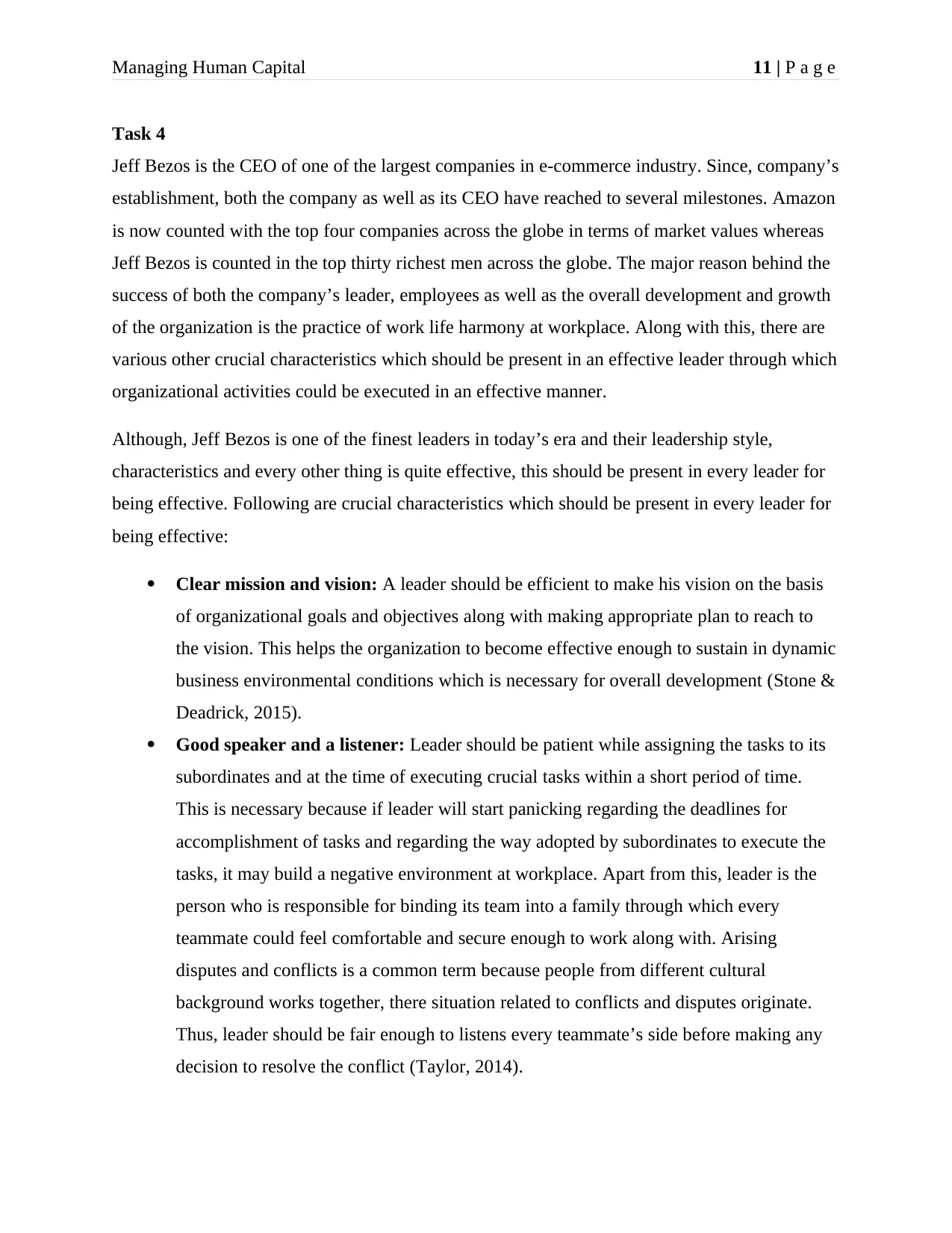
Managing Human Capital 11 | P a g e
Task 4
Jeff Bezos is the CEO of one of the largest companies in e-commerce industry. Since, company’s
establishment, both the company as well as its CEO have reached to several milestones. Amazon
is now counted with the top four companies across the globe in terms of market values whereas
Jeff Bezos is counted in the top thirty richest men across the globe. The major reason behind the
success of both the company’s leader, employees as well as the overall development and growth
of the organization is the practice of work life harmony at workplace. Along with this, there are
various other crucial characteristics which should be present in an effective leader through which
organizational activities could be executed in an effective manner.
Although, Jeff Bezos is one of the finest leaders in today’s era and their leadership style,
characteristics and every other thing is quite effective, this should be present in every leader for
being effective. Following are crucial characteristics which should be present in every leader for
being effective:
Clear mission and vision: A leader should be efficient to make his vision on the basis
of organizational goals and objectives along with making appropriate plan to reach to
the vision. This helps the organization to become effective enough to sustain in dynamic
business environmental conditions which is necessary for overall development (Stone &
Deadrick, 2015).
Good speaker and a listener: Leader should be patient while assigning the tasks to its
subordinates and at the time of executing crucial tasks within a short period of time.
This is necessary because if leader will start panicking regarding the deadlines for
accomplishment of tasks and regarding the way adopted by subordinates to execute the
tasks, it may build a negative environment at workplace. Apart from this, leader is the
person who is responsible for binding its team into a family through which every
teammate could feel comfortable and secure enough to work along with. Arising
disputes and conflicts is a common term because people from different cultural
background works together, there situation related to conflicts and disputes originate.
Thus, leader should be fair enough to listens every teammate’s side before making any
decision to resolve the conflict (Taylor, 2014).
Task 4
Jeff Bezos is the CEO of one of the largest companies in e-commerce industry. Since, company’s
establishment, both the company as well as its CEO have reached to several milestones. Amazon
is now counted with the top four companies across the globe in terms of market values whereas
Jeff Bezos is counted in the top thirty richest men across the globe. The major reason behind the
success of both the company’s leader, employees as well as the overall development and growth
of the organization is the practice of work life harmony at workplace. Along with this, there are
various other crucial characteristics which should be present in an effective leader through which
organizational activities could be executed in an effective manner.
Although, Jeff Bezos is one of the finest leaders in today’s era and their leadership style,
characteristics and every other thing is quite effective, this should be present in every leader for
being effective. Following are crucial characteristics which should be present in every leader for
being effective:
Clear mission and vision: A leader should be efficient to make his vision on the basis
of organizational goals and objectives along with making appropriate plan to reach to
the vision. This helps the organization to become effective enough to sustain in dynamic
business environmental conditions which is necessary for overall development (Stone &
Deadrick, 2015).
Good speaker and a listener: Leader should be patient while assigning the tasks to its
subordinates and at the time of executing crucial tasks within a short period of time.
This is necessary because if leader will start panicking regarding the deadlines for
accomplishment of tasks and regarding the way adopted by subordinates to execute the
tasks, it may build a negative environment at workplace. Apart from this, leader is the
person who is responsible for binding its team into a family through which every
teammate could feel comfortable and secure enough to work along with. Arising
disputes and conflicts is a common term because people from different cultural
background works together, there situation related to conflicts and disputes originate.
Thus, leader should be fair enough to listens every teammate’s side before making any
decision to resolve the conflict (Taylor, 2014).
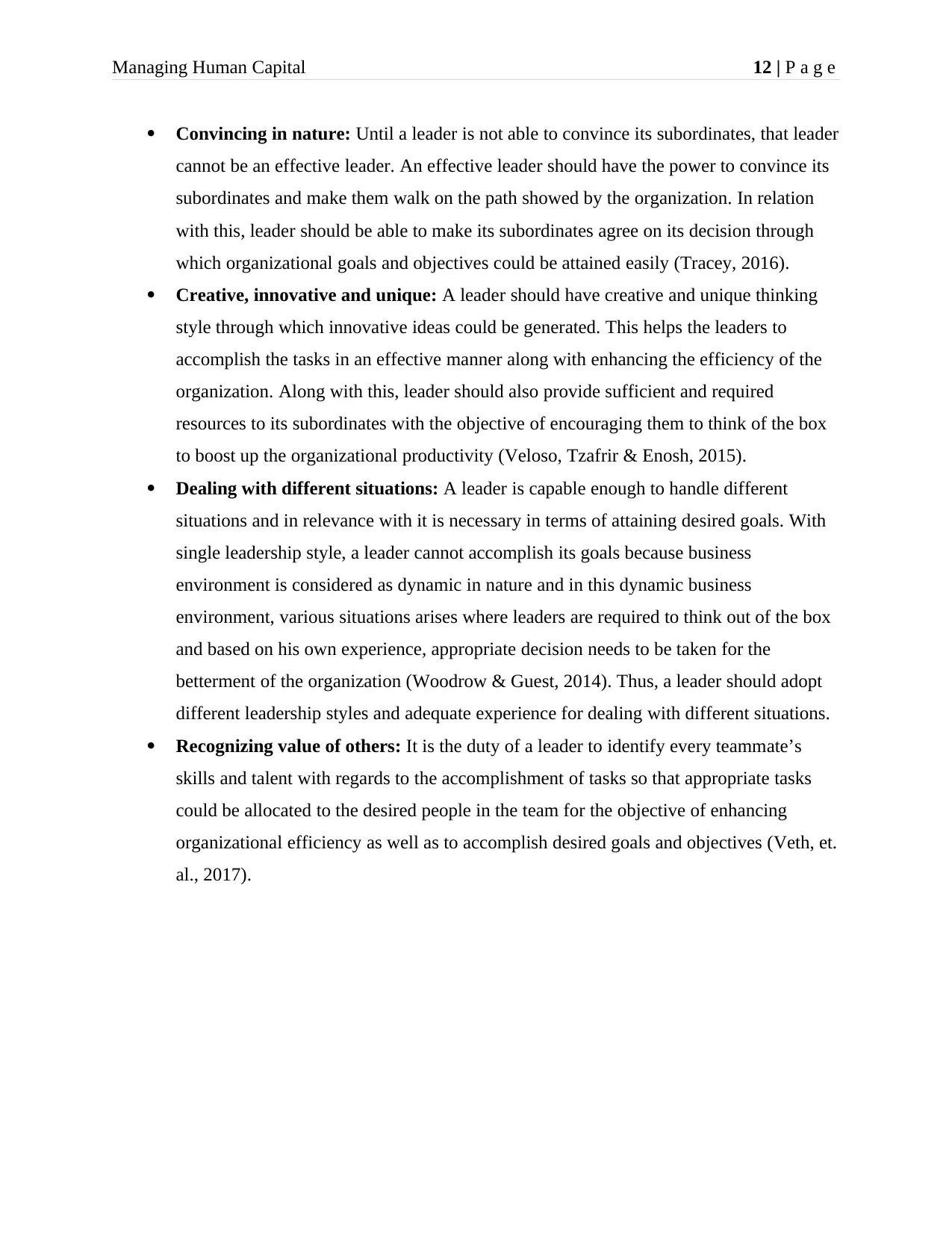
Managing Human Capital 12 | P a g e
Convincing in nature: Until a leader is not able to convince its subordinates, that leader
cannot be an effective leader. An effective leader should have the power to convince its
subordinates and make them walk on the path showed by the organization. In relation
with this, leader should be able to make its subordinates agree on its decision through
which organizational goals and objectives could be attained easily (Tracey, 2016).
Creative, innovative and unique: A leader should have creative and unique thinking
style through which innovative ideas could be generated. This helps the leaders to
accomplish the tasks in an effective manner along with enhancing the efficiency of the
organization. Along with this, leader should also provide sufficient and required
resources to its subordinates with the objective of encouraging them to think of the box
to boost up the organizational productivity (Veloso, Tzafrir & Enosh, 2015).
Dealing with different situations: A leader is capable enough to handle different
situations and in relevance with it is necessary in terms of attaining desired goals. With
single leadership style, a leader cannot accomplish its goals because business
environment is considered as dynamic in nature and in this dynamic business
environment, various situations arises where leaders are required to think out of the box
and based on his own experience, appropriate decision needs to be taken for the
betterment of the organization (Woodrow & Guest, 2014). Thus, a leader should adopt
different leadership styles and adequate experience for dealing with different situations.
Recognizing value of others: It is the duty of a leader to identify every teammate’s
skills and talent with regards to the accomplishment of tasks so that appropriate tasks
could be allocated to the desired people in the team for the objective of enhancing
organizational efficiency as well as to accomplish desired goals and objectives (Veth, et.
al., 2017).
Convincing in nature: Until a leader is not able to convince its subordinates, that leader
cannot be an effective leader. An effective leader should have the power to convince its
subordinates and make them walk on the path showed by the organization. In relation
with this, leader should be able to make its subordinates agree on its decision through
which organizational goals and objectives could be attained easily (Tracey, 2016).
Creative, innovative and unique: A leader should have creative and unique thinking
style through which innovative ideas could be generated. This helps the leaders to
accomplish the tasks in an effective manner along with enhancing the efficiency of the
organization. Along with this, leader should also provide sufficient and required
resources to its subordinates with the objective of encouraging them to think of the box
to boost up the organizational productivity (Veloso, Tzafrir & Enosh, 2015).
Dealing with different situations: A leader is capable enough to handle different
situations and in relevance with it is necessary in terms of attaining desired goals. With
single leadership style, a leader cannot accomplish its goals because business
environment is considered as dynamic in nature and in this dynamic business
environment, various situations arises where leaders are required to think out of the box
and based on his own experience, appropriate decision needs to be taken for the
betterment of the organization (Woodrow & Guest, 2014). Thus, a leader should adopt
different leadership styles and adequate experience for dealing with different situations.
Recognizing value of others: It is the duty of a leader to identify every teammate’s
skills and talent with regards to the accomplishment of tasks so that appropriate tasks
could be allocated to the desired people in the team for the objective of enhancing
organizational efficiency as well as to accomplish desired goals and objectives (Veth, et.
al., 2017).
Paraphrase This Document
Need a fresh take? Get an instant paraphrase of this document with our AI Paraphraser
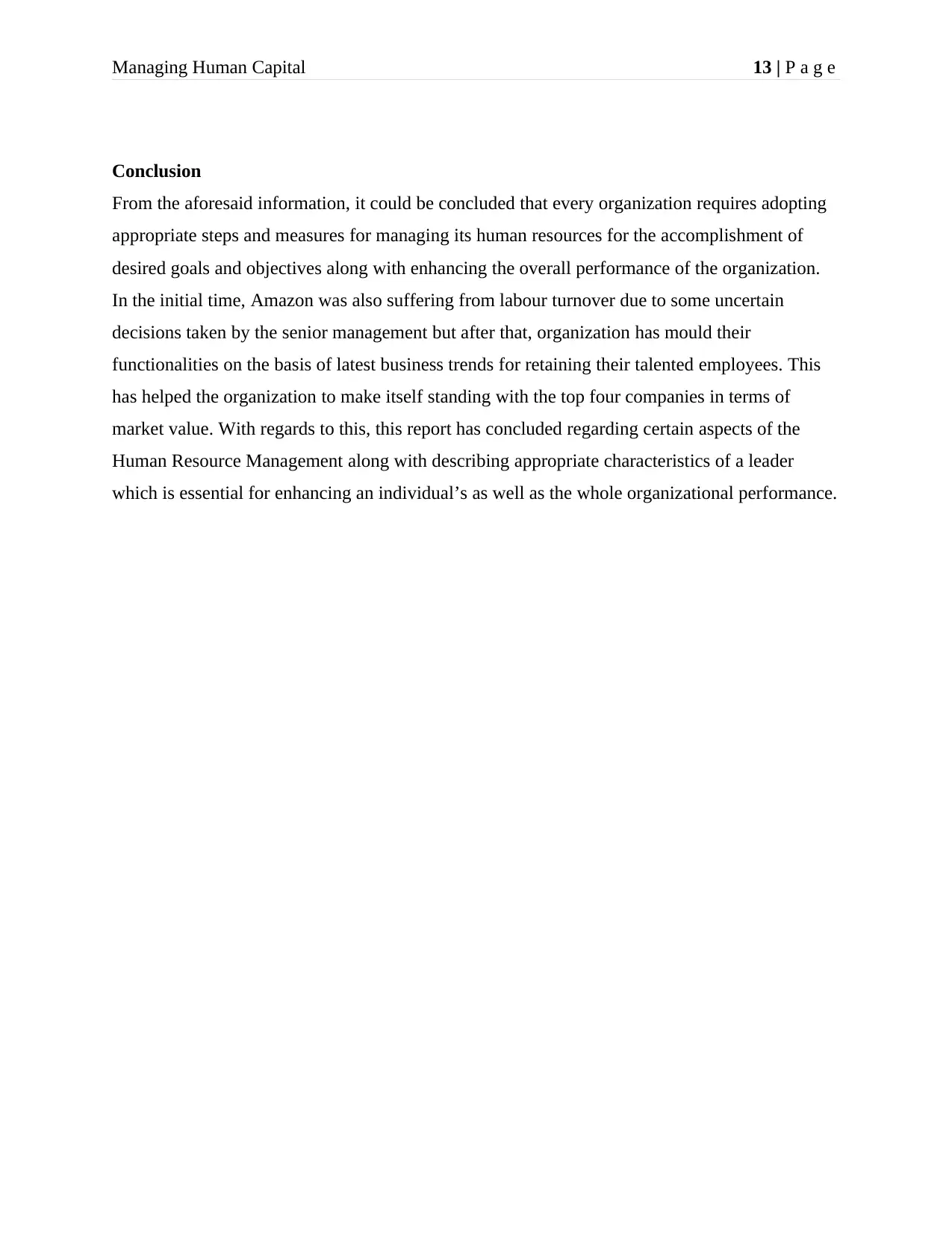
Managing Human Capital 13 | P a g e
Conclusion
From the aforesaid information, it could be concluded that every organization requires adopting
appropriate steps and measures for managing its human resources for the accomplishment of
desired goals and objectives along with enhancing the overall performance of the organization.
In the initial time, Amazon was also suffering from labour turnover due to some uncertain
decisions taken by the senior management but after that, organization has mould their
functionalities on the basis of latest business trends for retaining their talented employees. This
has helped the organization to make itself standing with the top four companies in terms of
market value. With regards to this, this report has concluded regarding certain aspects of the
Human Resource Management along with describing appropriate characteristics of a leader
which is essential for enhancing an individual’s as well as the whole organizational performance.
Conclusion
From the aforesaid information, it could be concluded that every organization requires adopting
appropriate steps and measures for managing its human resources for the accomplishment of
desired goals and objectives along with enhancing the overall performance of the organization.
In the initial time, Amazon was also suffering from labour turnover due to some uncertain
decisions taken by the senior management but after that, organization has mould their
functionalities on the basis of latest business trends for retaining their talented employees. This
has helped the organization to make itself standing with the top four companies in terms of
market value. With regards to this, this report has concluded regarding certain aspects of the
Human Resource Management along with describing appropriate characteristics of a leader
which is essential for enhancing an individual’s as well as the whole organizational performance.
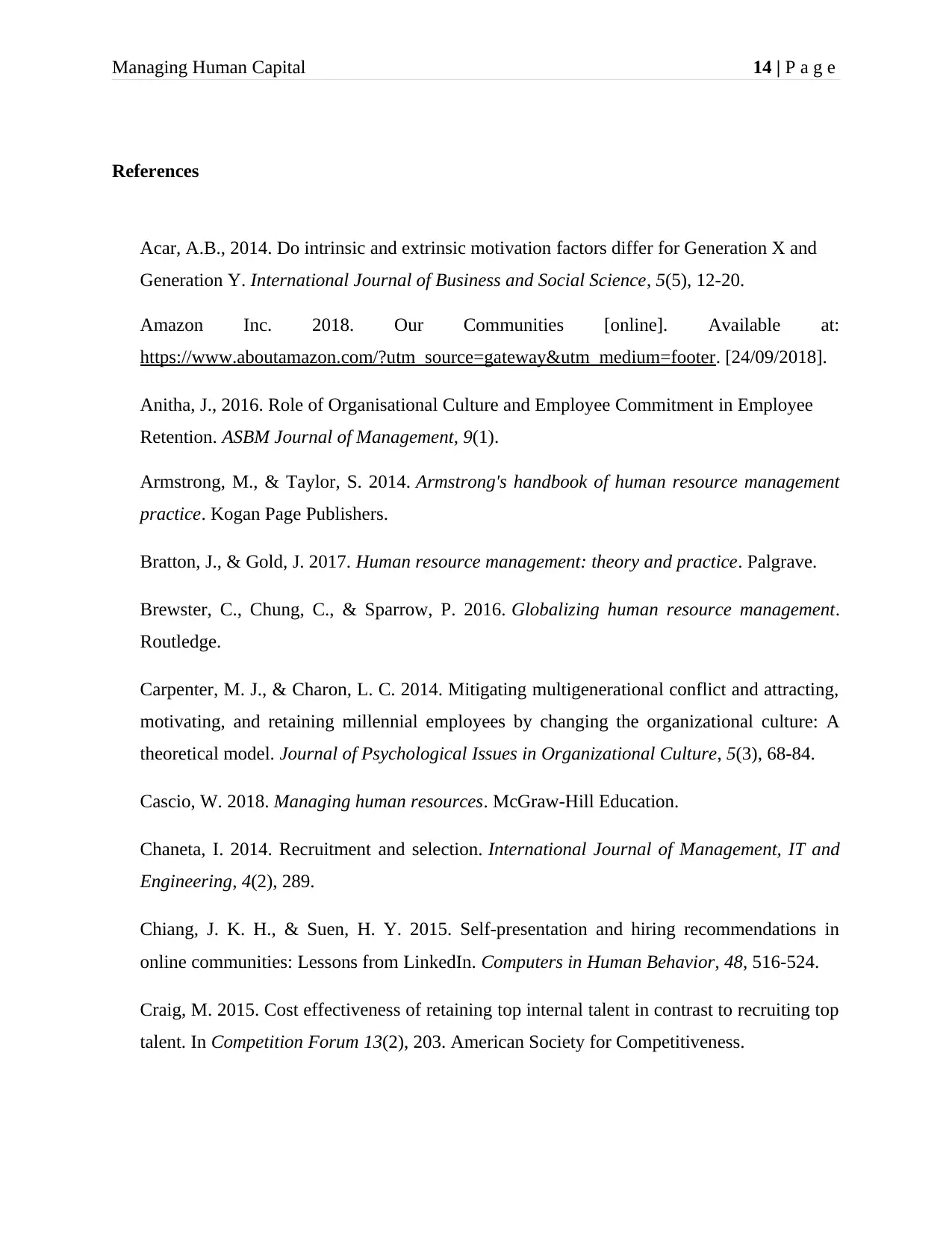
Managing Human Capital 14 | P a g e
References
Acar, A.B., 2014. Do intrinsic and extrinsic motivation factors differ for Generation X and
Generation Y. International Journal of Business and Social Science, 5(5), 12-20.
Amazon Inc. 2018. Our Communities [online]. Available at:
https://www.aboutamazon.com/?utm_source=gateway&utm_medium=footer. [24/09/2018].
Anitha, J., 2016. Role of Organisational Culture and Employee Commitment in Employee
Retention. ASBM Journal of Management, 9(1).
Armstrong, M., & Taylor, S. 2014. Armstrong's handbook of human resource management
practice. Kogan Page Publishers.
Bratton, J., & Gold, J. 2017. Human resource management: theory and practice. Palgrave.
Brewster, C., Chung, C., & Sparrow, P. 2016. Globalizing human resource management.
Routledge.
Carpenter, M. J., & Charon, L. C. 2014. Mitigating multigenerational conflict and attracting,
motivating, and retaining millennial employees by changing the organizational culture: A
theoretical model. Journal of Psychological Issues in Organizational Culture, 5(3), 68-84.
Cascio, W. 2018. Managing human resources. McGraw-Hill Education.
Chaneta, I. 2014. Recruitment and selection. International Journal of Management, IT and
Engineering, 4(2), 289.
Chiang, J. K. H., & Suen, H. Y. 2015. Self-presentation and hiring recommendations in
online communities: Lessons from LinkedIn. Computers in Human Behavior, 48, 516-524.
Craig, M. 2015. Cost effectiveness of retaining top internal talent in contrast to recruiting top
talent. In Competition Forum 13(2), 203. American Society for Competitiveness.
References
Acar, A.B., 2014. Do intrinsic and extrinsic motivation factors differ for Generation X and
Generation Y. International Journal of Business and Social Science, 5(5), 12-20.
Amazon Inc. 2018. Our Communities [online]. Available at:
https://www.aboutamazon.com/?utm_source=gateway&utm_medium=footer. [24/09/2018].
Anitha, J., 2016. Role of Organisational Culture and Employee Commitment in Employee
Retention. ASBM Journal of Management, 9(1).
Armstrong, M., & Taylor, S. 2014. Armstrong's handbook of human resource management
practice. Kogan Page Publishers.
Bratton, J., & Gold, J. 2017. Human resource management: theory and practice. Palgrave.
Brewster, C., Chung, C., & Sparrow, P. 2016. Globalizing human resource management.
Routledge.
Carpenter, M. J., & Charon, L. C. 2014. Mitigating multigenerational conflict and attracting,
motivating, and retaining millennial employees by changing the organizational culture: A
theoretical model. Journal of Psychological Issues in Organizational Culture, 5(3), 68-84.
Cascio, W. 2018. Managing human resources. McGraw-Hill Education.
Chaneta, I. 2014. Recruitment and selection. International Journal of Management, IT and
Engineering, 4(2), 289.
Chiang, J. K. H., & Suen, H. Y. 2015. Self-presentation and hiring recommendations in
online communities: Lessons from LinkedIn. Computers in Human Behavior, 48, 516-524.
Craig, M. 2015. Cost effectiveness of retaining top internal talent in contrast to recruiting top
talent. In Competition Forum 13(2), 203. American Society for Competitiveness.
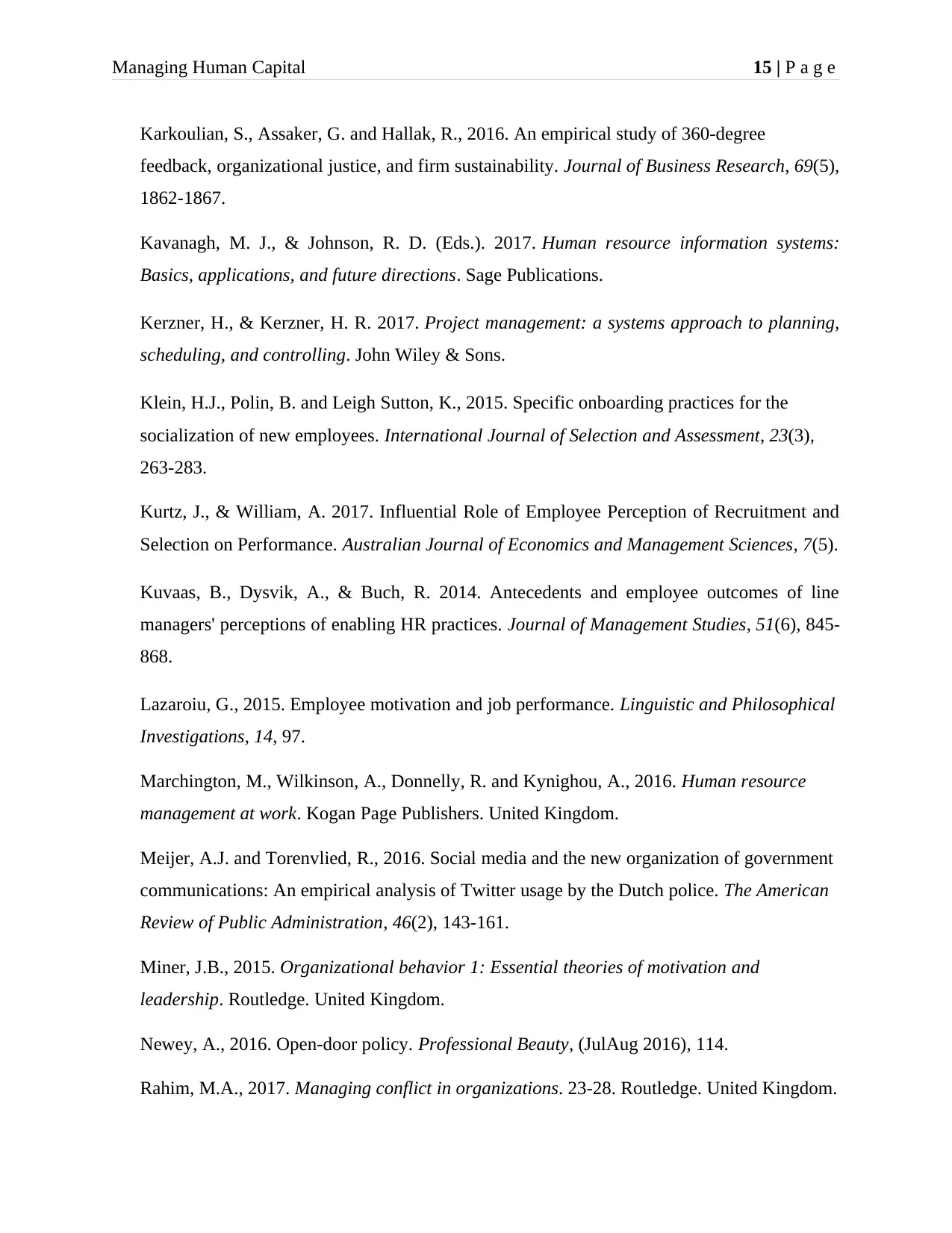
Managing Human Capital 15 | P a g e
Karkoulian, S., Assaker, G. and Hallak, R., 2016. An empirical study of 360-degree
feedback, organizational justice, and firm sustainability. Journal of Business Research, 69(5),
1862-1867.
Kavanagh, M. J., & Johnson, R. D. (Eds.). 2017. Human resource information systems:
Basics, applications, and future directions. Sage Publications.
Kerzner, H., & Kerzner, H. R. 2017. Project management: a systems approach to planning,
scheduling, and controlling. John Wiley & Sons.
Klein, H.J., Polin, B. and Leigh Sutton, K., 2015. Specific onboarding practices for the
socialization of new employees. International Journal of Selection and Assessment, 23(3),
263-283.
Kurtz, J., & William, A. 2017. Influential Role of Employee Perception of Recruitment and
Selection on Performance. Australian Journal of Economics and Management Sciences, 7(5).
Kuvaas, B., Dysvik, A., & Buch, R. 2014. Antecedents and employee outcomes of line
managers' perceptions of enabling HR practices. Journal of Management Studies, 51(6), 845-
868.
Lazaroiu, G., 2015. Employee motivation and job performance. Linguistic and Philosophical
Investigations, 14, 97.
Marchington, M., Wilkinson, A., Donnelly, R. and Kynighou, A., 2016. Human resource
management at work. Kogan Page Publishers. United Kingdom.
Meijer, A.J. and Torenvlied, R., 2016. Social media and the new organization of government
communications: An empirical analysis of Twitter usage by the Dutch police. The American
Review of Public Administration, 46(2), 143-161.
Miner, J.B., 2015. Organizational behavior 1: Essential theories of motivation and
leadership. Routledge. United Kingdom.
Newey, A., 2016. Open-door policy. Professional Beauty, (JulAug 2016), 114.
Rahim, M.A., 2017. Managing conflict in organizations. 23-28. Routledge. United Kingdom.
Karkoulian, S., Assaker, G. and Hallak, R., 2016. An empirical study of 360-degree
feedback, organizational justice, and firm sustainability. Journal of Business Research, 69(5),
1862-1867.
Kavanagh, M. J., & Johnson, R. D. (Eds.). 2017. Human resource information systems:
Basics, applications, and future directions. Sage Publications.
Kerzner, H., & Kerzner, H. R. 2017. Project management: a systems approach to planning,
scheduling, and controlling. John Wiley & Sons.
Klein, H.J., Polin, B. and Leigh Sutton, K., 2015. Specific onboarding practices for the
socialization of new employees. International Journal of Selection and Assessment, 23(3),
263-283.
Kurtz, J., & William, A. 2017. Influential Role of Employee Perception of Recruitment and
Selection on Performance. Australian Journal of Economics and Management Sciences, 7(5).
Kuvaas, B., Dysvik, A., & Buch, R. 2014. Antecedents and employee outcomes of line
managers' perceptions of enabling HR practices. Journal of Management Studies, 51(6), 845-
868.
Lazaroiu, G., 2015. Employee motivation and job performance. Linguistic and Philosophical
Investigations, 14, 97.
Marchington, M., Wilkinson, A., Donnelly, R. and Kynighou, A., 2016. Human resource
management at work. Kogan Page Publishers. United Kingdom.
Meijer, A.J. and Torenvlied, R., 2016. Social media and the new organization of government
communications: An empirical analysis of Twitter usage by the Dutch police. The American
Review of Public Administration, 46(2), 143-161.
Miner, J.B., 2015. Organizational behavior 1: Essential theories of motivation and
leadership. Routledge. United Kingdom.
Newey, A., 2016. Open-door policy. Professional Beauty, (JulAug 2016), 114.
Rahim, M.A., 2017. Managing conflict in organizations. 23-28. Routledge. United Kingdom.
Secure Best Marks with AI Grader
Need help grading? Try our AI Grader for instant feedback on your assignments.
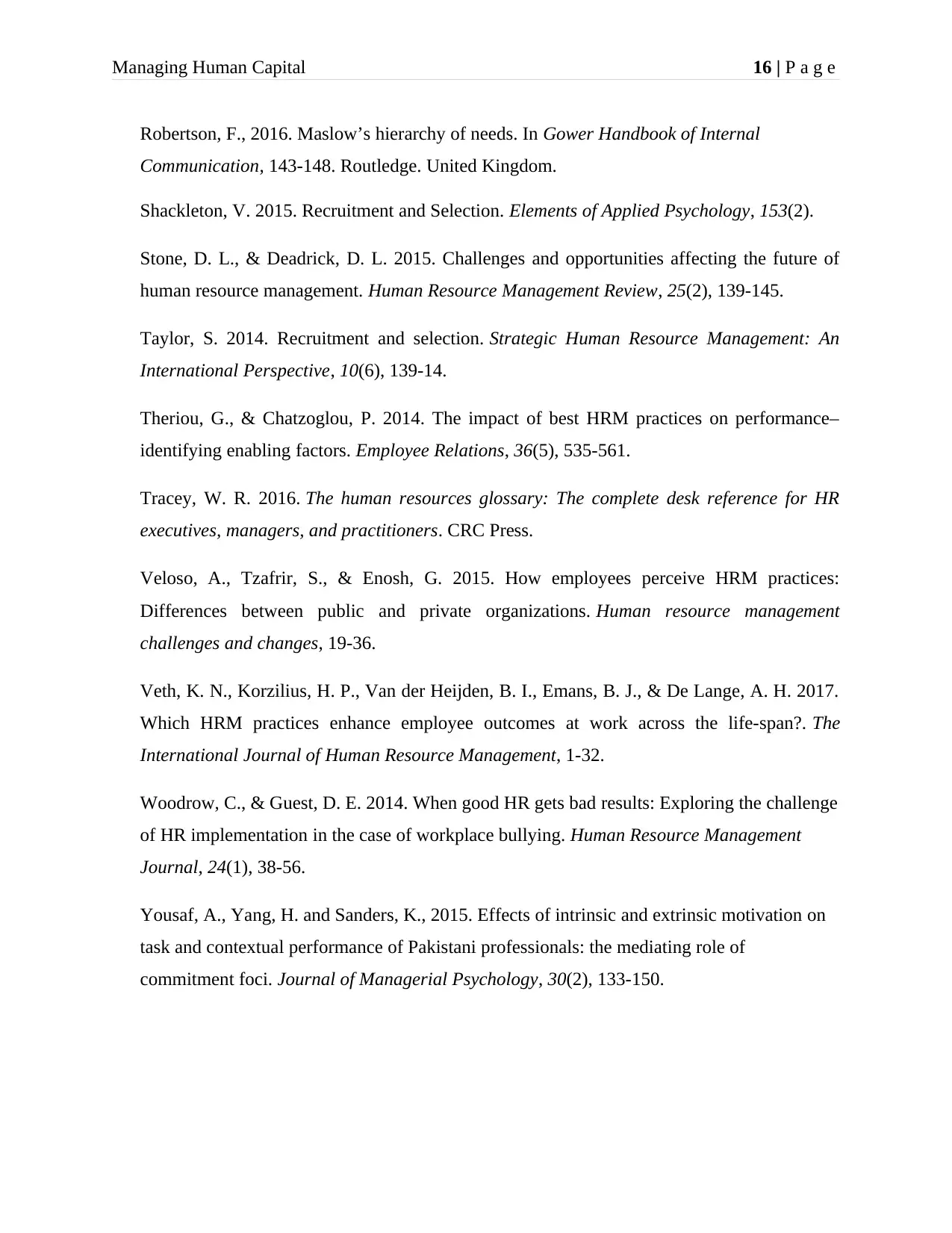
Managing Human Capital 16 | P a g e
Robertson, F., 2016. Maslow’s hierarchy of needs. In Gower Handbook of Internal
Communication, 143-148. Routledge. United Kingdom.
Shackleton, V. 2015. Recruitment and Selection. Elements of Applied Psychology, 153(2).
Stone, D. L., & Deadrick, D. L. 2015. Challenges and opportunities affecting the future of
human resource management. Human Resource Management Review, 25(2), 139-145.
Taylor, S. 2014. Recruitment and selection. Strategic Human Resource Management: An
International Perspective, 10(6), 139-14.
Theriou, G., & Chatzoglou, P. 2014. The impact of best HRM practices on performance–
identifying enabling factors. Employee Relations, 36(5), 535-561.
Tracey, W. R. 2016. The human resources glossary: The complete desk reference for HR
executives, managers, and practitioners. CRC Press.
Veloso, A., Tzafrir, S., & Enosh, G. 2015. How employees perceive HRM practices:
Differences between public and private organizations. Human resource management
challenges and changes, 19-36.
Veth, K. N., Korzilius, H. P., Van der Heijden, B. I., Emans, B. J., & De Lange, A. H. 2017.
Which HRM practices enhance employee outcomes at work across the life-span?. The
International Journal of Human Resource Management, 1-32.
Woodrow, C., & Guest, D. E. 2014. When good HR gets bad results: Exploring the challenge
of HR implementation in the case of workplace bullying. Human Resource Management
Journal, 24(1), 38-56.
Yousaf, A., Yang, H. and Sanders, K., 2015. Effects of intrinsic and extrinsic motivation on
task and contextual performance of Pakistani professionals: the mediating role of
commitment foci. Journal of Managerial Psychology, 30(2), 133-150.
Robertson, F., 2016. Maslow’s hierarchy of needs. In Gower Handbook of Internal
Communication, 143-148. Routledge. United Kingdom.
Shackleton, V. 2015. Recruitment and Selection. Elements of Applied Psychology, 153(2).
Stone, D. L., & Deadrick, D. L. 2015. Challenges and opportunities affecting the future of
human resource management. Human Resource Management Review, 25(2), 139-145.
Taylor, S. 2014. Recruitment and selection. Strategic Human Resource Management: An
International Perspective, 10(6), 139-14.
Theriou, G., & Chatzoglou, P. 2014. The impact of best HRM practices on performance–
identifying enabling factors. Employee Relations, 36(5), 535-561.
Tracey, W. R. 2016. The human resources glossary: The complete desk reference for HR
executives, managers, and practitioners. CRC Press.
Veloso, A., Tzafrir, S., & Enosh, G. 2015. How employees perceive HRM practices:
Differences between public and private organizations. Human resource management
challenges and changes, 19-36.
Veth, K. N., Korzilius, H. P., Van der Heijden, B. I., Emans, B. J., & De Lange, A. H. 2017.
Which HRM practices enhance employee outcomes at work across the life-span?. The
International Journal of Human Resource Management, 1-32.
Woodrow, C., & Guest, D. E. 2014. When good HR gets bad results: Exploring the challenge
of HR implementation in the case of workplace bullying. Human Resource Management
Journal, 24(1), 38-56.
Yousaf, A., Yang, H. and Sanders, K., 2015. Effects of intrinsic and extrinsic motivation on
task and contextual performance of Pakistani professionals: the mediating role of
commitment foci. Journal of Managerial Psychology, 30(2), 133-150.
1 out of 17
Related Documents
Your All-in-One AI-Powered Toolkit for Academic Success.
+13062052269
info@desklib.com
Available 24*7 on WhatsApp / Email
![[object Object]](/_next/static/media/star-bottom.7253800d.svg)
Unlock your academic potential
© 2024 | Zucol Services PVT LTD | All rights reserved.




